#the most similar in terms of presentation would be tom in 2016 i think like that sense of all in fully public from the get go
Explore tagged Tumblr posts
Note
Also this relationship feels different than her older public relationships. Even her relationship with Calvin Harris wasn’t this exposed
I agree, also I feel like with calvin it sort of became more public over the longer span of the relationship (also on the topic of this comparison every time I see someone call them "tayvis" it always just makes me think of "tayvin" and how probably a lot of how people raving about them now is the same as what was being said back then just with a slightly different ship name)
#the most similar in terms of presentation would be tom in 2016 i think like that sense of all in fully public from the get go#but i get a much more lowkey private vibe from tom overall#anonymous#answered
3 notes
·
View notes
Text
#703: 'Marketa Lazarová', dir. František Vláčil, 1967.
Marketa Lazarová is a slightly unusual film for me, because its effects go slightly beyond my ability to articulate or explain them. I originally saw it at a Film Society screening in 2015 or 2016, back when I was able to go to movies at 6 p.m. on a Monday evening, and it enthralled me then, splayed wide across the screen at the Paramount in crisp black and white. I knew very little of Czech cinema at the time and, embarrassingly, still haven't seen very much. Coming back to it five years later, it still holds a lot of that arcane power that it had. Marketa Lazarová is simultaneously a meditative experience and a gut punch.

František Vláčil was one of the Czech filmmakers who was originally trained with the Army Film Division, which surprisingly became a breeding ground for avant-garde filmmaking styles. Vláčil became disillusioned with the types of historical films that were being produced at the time, which seemed to him to feature contemporary people pretending to be characters from the past. What was needed instead, he argued, was a more immediate form of historical cinema that made audiences feel like they were witnessing history rather than a lacklustre interpretation of it. In order to achieve this, he frequently joined his cast and crew on long-term shoots where they lived in the types of conditions that the characters would. Sets were built using traditional methods, and scripts were written using archaic dialects to avoid that common experience of characters speaking in a recognisably modern way. The shoot for Marketa Lazarová lasted almost two years in these conditions.
The film's plot concerns three groups. The Kozlík clan, a family under the helm of a robber baron, robs a noble entourage and takes Kristian, the son of the bishop, hostage. Before Kozlík's sons can return to claim their loot, a neighbouring clan led by Lazar steals the spoils. Lazar is saved from being killed when a vision of a nunnery on a hillside appears. One of the chief themes of this film, alluded to early on, is the conflict between paganism and early Christianity. The two worldviews are muddy and indistinct, but the difference between them is what drives a lot of the retribution in the film. Kristian falls in love with one of Kozlík's daughters, Alexandra, while Kozlík's son, Mikoláš, falls in love with Lazar's daughter, Marketa, whom he has taken as a hostage in retaliation for Lazar refusing to side with Kozlík against the king and the bishop. In addition to the religious dimension, then, there is also an ongoing theme of where one's loyalties lie - with existing morals (family, God) or with the person you love. Over the course of this epic, the fates of all three groups trend downhill: members of each of these bands are slaughtered and betrayed; Kozlík and Alexandra are imprisoned; Marketa is released by Mikoláš but rejected by Lazar. The film's conclusion seems to suggest that it is Marketa, and the future generations she helps to bring into the world, that will be able to overcome the divisions that affected the clans so catastrophically, but also acknowledges that these types of conflicts are part of the human experience.
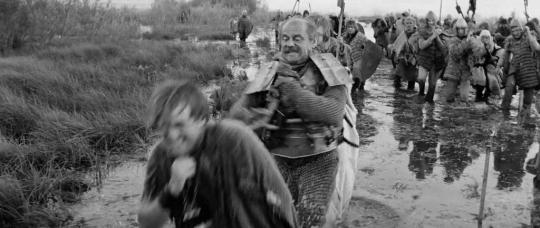
As vast and interwoven the plot of the film is, it's not what makes the experience of watching quite so transcendent. What makes this film feel like an out-of-body experience is Vláčil's use of non-linear and non-realistic techniques. Parts of the film's story are told in flashback, but without any explicit indication that this is happening. At times we see disconnected, hallucinatory images that only make sense when they are contextualised later on. One example of this is an erotic scene between Alexandra (Pavla Polášková) and a young man, who we assume to be Kristian (Vlastimil Harapes). It's only later that we discover that this is a flashback to an abortive romance between Alexandra and her brother Adam (Ivan Palúch) - a man I had initially disqualified from appearing here because Adam only has one arm in the current scenes. Revealing that it is Adam propels the story forward in traditionally linear fashion, but also causes the viewer to reassess the film's earlier scene to determine why these images are included there. These images are made further alien by their unexpected visual qualities: the sex scene takes place in a field of summer grain, but most of the film's 'present day' takes place in winter and early spring. Rather than ascribe them to an unmotivated flashback, it seems easier to read them as a poetic hallucination, and then Vláčil returns to reorganise what we had previously believed of the narrative.
As well as the narrative structure, Vláčil frequently employs long periods of silence and a seeming mismatch of cinematography, where figures are either oddly close to the camera or absurdly far away. On a deep level, it feels like nobody, even the director, has total control over what is being portrayed - like we've entered a kind of fugue state in which cinema just happens regardless of how legible its results are. Although its filming process was so long, the resulting scenes feel accidental or improvisational, culled down from a vast amount of footage.
While many of these techniques give us the experience of watching a dream of an imagined past, these techniques are also quite violent and confrontational. Even when the shots are distant or filmed in long takes, they're cut together in a jarring way, and the lack of a straightforward narrative makes it difficult on the viewer too. The activity implied in this method of editing, a complicated soundscape and opaque narrative combine to make Marketa Lazarová a film that feels very immediate and present. As Tom Gunning put it, writing for Criterion about his early encounters with the film, "an energized mobile camera and abrasive editing peers into a primitive era of human history." Just as the characters of the film are quick to anger and quick to act, the film also lacks temperance. This is a film of life and death in its most vital forms, and so it makes a certain kind of sense that Vláčil would, in defiance of the typical historical film, try and remove any layer of modern logic or reason that would prevent us from experiencing the film's events in a visceral way. This is also why the myth of the werewolf hangs so heavily over the film - invoked a few times by Kozlík's wife, and present in the appearance of his children and their uncanny survival abilities - it both defies modern logic and refers to a particularly corporeal type of monster.
Vláčil structures Marketa Lazarová with sudden intertitles that refer to the events and themes that we are about to see, in a poetic way that recalls the chapter titles of a 19th-century novel. 'On the Lot of Widows' and 'Who in the Past Brewed with Hops' provide the vantage point of someone placed about the action, narrating it to us in a distant sort of way. The music is similar: both ancient and modern, it frequently uses atonal incantations. Taken together, it feels like this story is being shouted at us from a distant time when things were more tactile. "The presence of animals and plants, the textures of stone and tree bark, of snow and marsh water," Gunning writes, "cling to us as we watch, often overriding the narrative."

The grand experience of watching this film is partly contradictory, then: this is a film that feels very modern, tells a story from the past, alludes to contemporary struggles, and when situated in Czech film history is wildly experimental. Gunning sees this film as being, in some respects, a statement about what Vláčil thought cinema could be, in those days of the 1960s where most national cinemas were experiencing their own variations on the New Wave that had developed in France. The experimental aspects of the films of Godard and Varda would be subsumed into the traditional toolbox of cinema and lose some of their vibrancy as a result - either directors would use them for blockbuster films or extend them into a new type of experimental film that was sterile and aloof.Considering this, it's worth appreciating exactly how daring Vláčil was being here: under a Communist regime, making a film about paganism, bestiality, sadism, incest, and torture. With all this darkness, Marketa Lazarová is a bright film, even funny at times. Humanity is a fallen, self-destructive thing, but there is something about this way of life, before it was layered deep underneath civilisation, reason and enlightenment, that was exciting and vibrant.
Does civilisation mean we lose something of our potential? The final narration of Marketa Lazarová tells us that these cycles of mistrust and anger are likely to repeat through the generations, but is that a price Vláčil thinks is worth paying? The urgency and difficulty of life in the distant past was inseparable from the superstitions of the time, but the urges were easier to sate, at least temporarily. The taming of these clans, like the taming of the avant-garde techniques Vláčil employs here, might have been inevitable, but this film shows that there is something valuable there nonetheless.
10 notes
·
View notes
Link
via Politics – FiveThirtyEight
Former special counsel Robert Mueller gave short, clipped answers in front of two House committees last Wednesday, and he provided almost no new information about his investigation into the 2016 election and Russian interference during his testimony. But his appearance nonetheless seems to have bolstered the movement on Capitol Hill to impeach President Trump. Since Mueller testified, more than a dozen additional Democratic House members have come out in support of at least beginning a formal impeachment investigation. The total number of House Democrats favoring impeachment has reached about 109, according to lists from The New York Times and The Washington Post — nearly half of the 235-person Democratic caucus.1
In fact, it’s likely that there will soon be a pro-impeachment majority among House Democrats. A Democratic majority for impeachment is potentially (more on this in a moment) an important milestone in the months-long debate over exactly how Democrats should react to the Mueller’ Report, which included descriptions of a number of actions by Trump that could constitute obstruction of justice.
Why is a pro-impeachment majority likely? Because there are plenty of Democrats who have yet to come out for impeachment but who face similar political pressures to those who already have. The 109 Democrats who currently favor impeachment, not surprisingly, mostly represent very liberal districts; on average, Trump lost those districts in 2016 by about 38 percentage points. (Trump lost the average Democratic-held House district by 28 percentage points, and he lost the average district with a member not supporting impeachment yet by 20 points.) Of the 126 Democrats who are not yet on board with impeachment, 29 represent districts where Trump lost by at least 38 points. If just nine of those 29 embraced impeachment, the pro-impeachment wing of House Democrats would have a majority.
Impeachment holdouts in very blue districts
Democratic members who don’t support impeachment in districts that Hillary Clinton won by more than her margin in the average pro-impeachment district*
Name District Clinton’s Margin Nancy Pelosi CA-12 +78 John Lewis GA-5 +73 Gregory W. Meeks NY-5 +73 Hakeem Jeffries NY-8 +71 Frederica Wilson FL-24 +68 Alcee L. Hastings FL-20 +62 Eddie Bernice Johnson TX-30 +61 Jerrold Nadler NY-10 +60 Anthony Brown MD-4 +58 Elijah Cummings MD-7 +56 Albio Sires NJ-8 +54 Anna G. Eshoo CA-18 +53 Ro Khanna CA-17 +53 Hank Johnson GA-4 +53 Eliot Engel NY-16 +53 Zoe Lofgren CA-19 +51 Adam Schiff CA-28 +50 Marc Veasey TX-33 +49 Jimmy Panetta CA-20 +47 Sylvia R. Garcia TX-29 +46 Mike Thompson CA-5 +45 David Scott GA-13 +44 Brad Sherman CA-30 +43 Terri A. Sewell AL-7 +41 David Price NC-4 +40 Linda Sánchez CA-38 +40 Gerald E. Connolly VA-11 +39 J. Luis Correa CA-46 +38 Judy Chu CA-27 +38
*Clinton won pro-impeachment districts with an average of 37.6 percentage points.
Sources: The New York Times, the Washington Post
Those 29 members, representing such liberal districts, are likely to face some pressure to get on board. Polling suggests that while a majority of Americans oppose impeachment, a clear majority of Democrats favor it. In a congressional district where Trump lost by 38 percentage points, the sentiment is likely to be heavily in favor of impeachment.
It’s not that these House members will necessarily face primary challenges if they don’t join the impeachment push. But with the House now on a six-week recess, it’s likely that many of these members will be asked about impeachment by their constituents in their home districts, and I suspect few of them want to defend Trump’s conduct on the merits. So they are likely to suggest that impeachment will be both divisive to the country and relatively useless, since the Senate almost certainly will not remove Trump from office.
Some of these members can probably sustain an anti-impeachment position along those lines. But others will likely buckle and join the pro-impeachment push.
For now, though, those 29 members in heavily-Democratic districts who have not yet supported impeachment comprise an interesting group. Nearly all have at least one of three characteristics: They are black; they are from California; they are in Democratic leadership.
That members in leadership are holding out makes sense. As long as House Speaker Nancy Pelosi maintains that impeachment isn’t the best course, her leadership team is likely to hold that position. (Incidentally, Pelosi is the Democratic holdout in the most anti-Trump district — Trump lost there by 78 points.)
The California and black blocs present a more nuanced case. I suspect the California members, in particular, both respect Pelosi’s judgment that impeachment is politically unwise and may be holding off support for impeachment in deference to her. Many of the black members are close to Pelosi, as well. But I wonder if we are also seeing the same practical streak (Trump is not actually going to be removed) among Congressional Black Caucus members that we are seeing among black voters, who are embracing Joe Biden in part because they perceive other Democratic presidential candidates as less safe bets against Trump in a general election. Maybe a CBC member can convince his or her constituents, who are likely extremely opposed to Trump, that a failed impeachment process could help the president win a second term.
Whatever their rationales, I don’t think nearly all of these people can hold off on embracing impeachment. And there is another bloc of more than two dozen Democrats who are not yet in support of impeachment and represent slightly less blue districts where Clinton still won by at least 20 percentage points in 2016. These members don’t face any real electoral danger and are also in strongly liberal districts, so their constituents may push them to embrace impeachment.
What about the rest of the Democrats — those who aren’t in very liberal districts? Their behavior gives ammunition to both the anti- and pro-impeachment forces in the party. Broadly, this bloc is wary of impeachment, reinforcing the stance of Pelosi and the anti-impeachment group. Of the 64 Democrats who represent districts where Clinton won by 10 points or less (including districts won by Trump) just 14 members support impeachment. Only one (New Hampshire’s Chris Pappas) of the 31 House Democrats in districts won by Trump in 2016 supports starting the impeachment process.
Where Democrats in purple and red districts stand
Democratic House members in districts that Hillary Clinton either won by 10 percentage points or less or lost
Name District Supports Impeachment Clinton’s Margin Kathleen Rice NY-4 ✓ +10 Jennifer Wexton VA-10 +10 Dean Phillips MN-3 +9 Raul Ruiz CA-36 +9 Gil Cisneros CA-39 +9 Jason Crow CO-6 +9 Chrissy Houlahan PA-6 +9 Mike Levin CA-49 ✓ +8 Andy Levin MI-9 ✓ +8 Sean Casten IL-6 ✓ +7 Tim Ryan OH-13 ✓ +7 Jim Langevin RI-2 +7 Stephanie Murphy FL-7 +7 Katie Hill CA-25 +7 Thomas Suozzi NY-3 +6 Ann Kirkpatrick AZ-2 ✓ +5 Katie Porter CA-45 ✓ +5 Steven A. Horsford NV-4 +5 Daniel Kildee MI-5 ✓ +4 Jahana Hayes CT-5 +4 Kurt Schrader OR-5 +4 Kim Schrier WA-8 ✓ +3 Joe Courtney CT-2 +3 Charlie Crist FL-13 +3 Josh Harder CA-10 +3 Ann Kuster NH-2 ✓ +2 Harley Rouda CA-48 ✓ +2 Colin Allred TX-32 +2 Tom Malinowski NJ-7 ✓ +1 Sharice Davids KS-3 +1 Lizzie Pannill Fletcher TX-7 +1 Susan Wild PA-7 +1 Peter DeFazio OR-4 ✓ 0 Angie Craig MN-2 -1 Josh Gottheimer NJ-5 -1 Susie Lee NV-3 -1 Mikie Sherrill NJ-11 -1 Cheri Bustos IL-17 -1 Tom O’Halleran AZ-1 -1 Chris Pappas NH-1 ✓ -2 Lucy McBath GA-6 -2 Sean Patrick Maloney NY-18 -2 Conor Lamb PA-17 -3 Elaine Luria VA-2 -3 Haley Stevens MI-11 -4 Cindy Axne IA-3 -4 Abby Finkenauer IA-1 -4 David Loebsack IA-2 -4 Lauren Underwood IL-14 -4 Jeff Van Drew NJ-2 -5 Ron Kind WI-3 -5 Andy Kim NJ-3 -6 Elissa Slotkin MI-8 -7 Abigail Spanberger VA-7 -7 Antonio Delgado NY-19 -7 Ben McAdams UT-4 -7 Matt Cartwright PA-8 -10 Jared Golden ME-2 -10 Max N. Rose NY-11 -10 Xochitl Torres Small NM-2 -10 Joe Cunningham SC-1 -13 Kendra Horn OK-5 -13 Anthony Brindisi NY-22 -16 Collin C. Peterson MN-7 -31
Sources: New York Times, Washington Post
Democrats, in theory, should be concerned about protecting the members who are most essential to the party having a majority in the House. Their opposition to impeachment sends a strong signal about how they’re reading the politics in their home districts. Also, an impeachment resolution would not get the necessary 218 votes to pass without most of the 31 Democrats in Trump districts voting “yes” on it, assuming all Republicans stand with the president. A failed impeachment vote in the House, never mind the Senate, would be quite embarrassing for Democrats.
On the other hand, pro-impeachment members like New Jersey’s Tom Malinowski and California’s Katie Porter, who both won GOP-held districts in November, give the pro-impeachment forces in the party a valuable talking point: If Malinowski (Clinton won his district by just 1 percentage point) supports impeachment, why is New York’s Gregory Meeks (Clinton won by 73 points in his district) not on board? The pro-impeachment stance of members like Porter is part of the reason why I think more members in “safe” districts will be effectively forced to join her.
But here’s the thing: A majority of House Democrats being for impeachment doesn’t inherently mean anything. Even after that majority is reached, maybe Pelosi still keeps impeachment proceedings on ice. Maybe some of the pro-impeachment members know that they are taking a stand with no consequences, because Pelosi has assured them privately that she will stop impeachment from going forward no matter what.
At the same time, pro-impeachment sentiment, at least among Democrats, seems to be building. It’s easy to imagine that the dam has broken and that House Democrats, particularly those representing very liberal areas, feel like they can simply no longer defend their opposition to impeachment. If, say, 150 Democrats are for impeachment a month from now, watch out. Pelosi may not be able to sideline that big a pro-impeachment bloc.
4 notes
·
View notes
Text
UNIT SIX// PROJECT: FILM// REFERENCES
Salut Les Cubains- Agnes Varda (1963)
Salut Les Cubains is a 30 min short documentary film made by Varda during her visit to Cuba in 1963. It explores Cuban society and culture post revolution. The most interesting thing about this film is that is made entirely out of a compilation of still images. They are edited together to create the illusion of movement while still retaining a jerky low-frame rate effect. This effect works extremely well when edited to match the accompanying music- to which the people appear to dance. The jumpy tone of the visuals along with the upbeat music creates a comic, light-hearted tone.
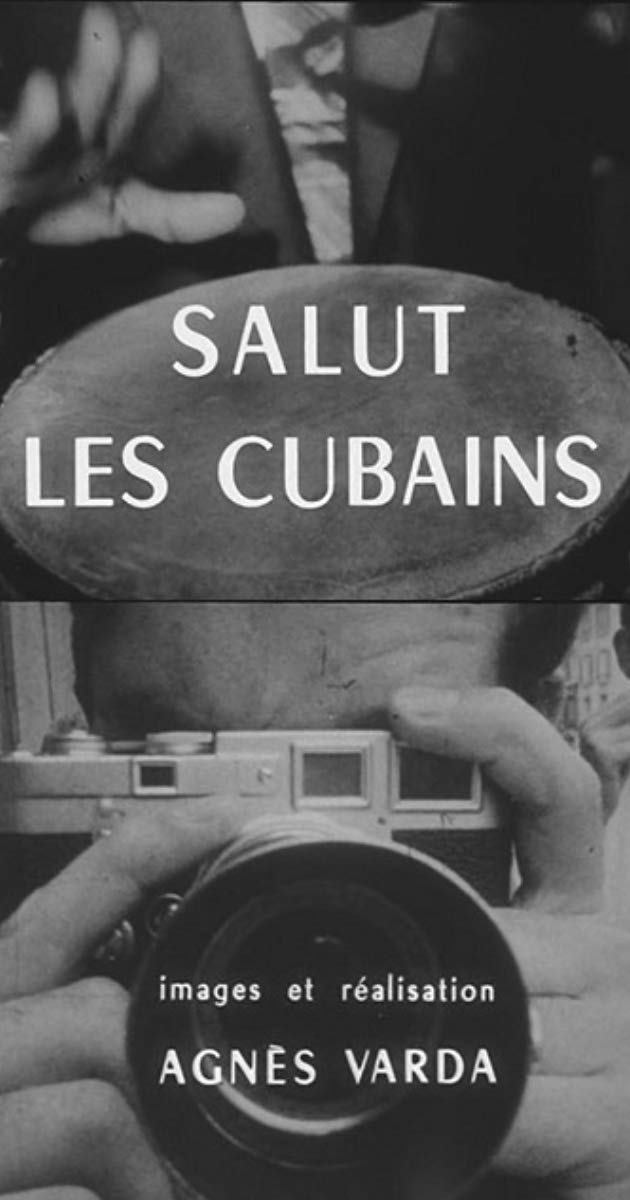
I thought the idea off using still images as frames for the film was a highly effective and original way to produce tone. However, I don’t think this would be appropriate for my work, as I don’t think it suits the darker tone I am going for.

Mechanical Principals- Ralph Steiner- 1930
Mechanical Principals is a short silent film which documents the movements of mechanical parts. We see close up how pistons move up and down or side to side and pendulums sway, but never the larger machines that they are a part of, nor what they are manufacturing.

I found the focus on single parts of machinery, in silence, forced me to think about their movements in different ways than I normally would. The longer you look, the more mesmerised you become with the rhythmic repetition of the parts, and the more you see the beauty in them- where you would usually ignore or dismiss them. I really enjoyed this technique and think that perhaps zooming in to remove context may be something I’m interested in doing for my film.
Snow- Geoffrey Jones- 1963
Snow is a short documentary film made by Geoffrey Jones for British Transport Films in 1962-1963. The 8-minute-long film shows the efforts of British Railways staff in coping with the 1963 United Kingdom cold wave. An example of "pure cinema", it was nominated for an Academy Award in 1965.- Wikipedia

This film was one of my favourites that was shown during the briefing. I thought that the gradual speeding up of both the music and the visuals shown in the film was very effective in portraying a feeling of resolution and engaging the audience in a semblance of a ‘plot’ despite disconnected images. Fast cuts were made in the editing to create a real feeling of frantic plot movement in the film. I think I am going to look at this one further and use it as close reference for my own work.
Inner Passage Excerpt- Bill Viola- 2008
In this excerpt from a video installation piece by Bill Viola, a man embarks on a psychoactive journey across the Mojave desert. The film focuses on the physical body as it confronts extremes of endurance.

I found watching this film to be quite the visceral experience. Sensory images and sounds are combined along with quick cuts and a lack of music to create a disconcerting atmosphere which you can’t help but watch. A vertical format is use- which adds to the sense of realism because the modern day brain associates it with being filmed with a phone (or I did anyway) which added to the effect. The experience of watching this film was far from comfortable, and I was very interested in just how effective the editing was as inducing a physical reaction of of the audience. I think will look closer at this one and try to use some of the techniques in my own work.
An Ecstatic Experience- Ja’Tovia Gary- 2015
Brooklyn-based Ja’Tovia Gary’s six-minute film An Ecstatic Experience (2015), fuses an account of nineteenth-century slavery in the US South as recalled by a former slave in 1937, reenacted in 1965 and reedited for the twenty-first century. Black-and-white TV footage shows the American actress, poet and civil-rights activist Ruby Dee channelling Fannie Moore (a former enslaved woman) describing the revelatory moment at which her mother declared that their enslavement was over: ‘It troubled her in her heart, to know the way we was treated.’ -https://artreview.com/features/jan_feb_2019_future_greats_jatovia_gary/

The most interesting thing about this film stylistically is the fact that lines and shapes are drawn, or seemingly scratched straight into the film, and animated around the central figure. The film is also duplicated multiple times on screen to convey points of particularly high emotion. I really enjoyed the aesthetics of the animated lines, however I’m not sure if it would be appropriate for my piece. It was pointed out in the briefing that the lines actually distract from the actress in this film, making it hard to listen to what she is saying-which is a problem when what she is recounting is a story of great emotional and cultural weight. Although I liked the lines aesthetically, I didn't think they worked that well with the film- I thought they distorted the tone too much, which I think would also be the case if I used this technique in my own work.

Way of Ozu- Kogonada- 2016
Way of Ozu is a short film by ‘essay’ filmmaker Kogonada, which examines the repeat motifs, relationships and use of space in films by the Japanese master filmmaker Yasujiro Ozu.

This is done by comparison using three separate video frames within the piece, which allows Kogonada, and the audience to view three separate Ozu films at once and directly note their similarities/differences. The footage is perfectly timed to often give a domino/transitional effect between the three frames which I thought was particularly effective.
I am really interested in this style of filmmaking and my give this style a go for my film.

Grosse Fatigue- Camille Henrot- 2013
Grosse Fatigue is a short film intended to be displayed in a gallery space, showing a dense amount of video information presented in the form of Internet browser windows opening over the top of each other to form connections between imagery. The film is based off of found footage from Google searches and so ids very similar to the archive I have been trying to create for this project.
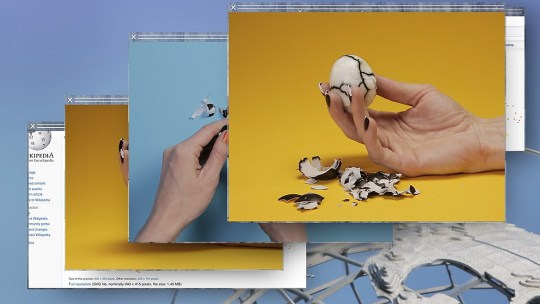
Henrot uses quick imagery and editing to create an overload of information. I found it very interesting that she uses the format of browser windows, it almost makes the film feel interactive- like it would be something you could do on your own computer, but at the same time presents pairs of imagery that I would have never grouped, but they work perfectly. I also found the idea of layering lots of video imagery on top of each other in different sizes to be an interesting technique. I don;’t know if it is appropriate for the tone I want in my film, but even so I thought it might be valuable to my project.
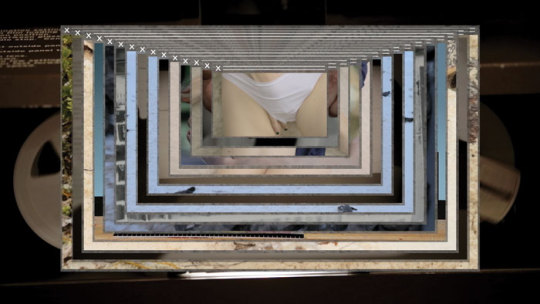
Sans Soleil (trailer)- Chris Marker- 1983
During the briefinf we watched a 30th anniversary trailer for Chris Markers film ‘Sans Soleil’. The film is a feature length experimental essay piece which compiles a series of thoughts, images and scenes mainly from Japan.

The trailer played many different clips from the film through the template of the text ‘sans soleil’ as a frame- so you were viewing the film directly through the title. This was an interesting way to see the film and an excellent idea for the trailer as it keeps you constantly aware of the name of the film. The saturation/contrast was turned up on some of the clips also, giving the elements an intense effect. I have not seen colour played with in any of the other references so far, so that opened up more ideas for my own film in terms of colour correction!
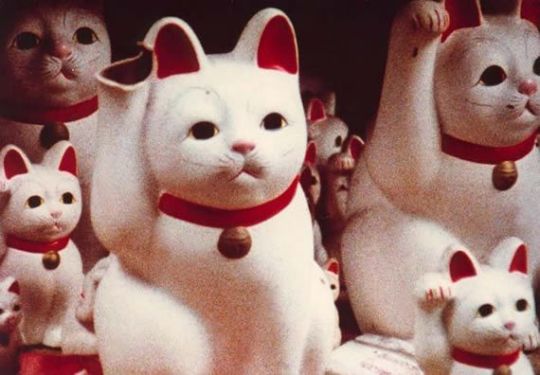
Trilogies- Susan Pui San Lok- 2015
Unfortunately I wasn’t able to view this film online- I think it was shown in a gallery space only during its exhibition. However, I did read about the film on the website linked in the brief. Trilogies uses clips from various TV adaptations of The Condor Trilogy produced between Hong Kong, China and Taiwan. It condenses 400 hours of footage into 195 minutes.
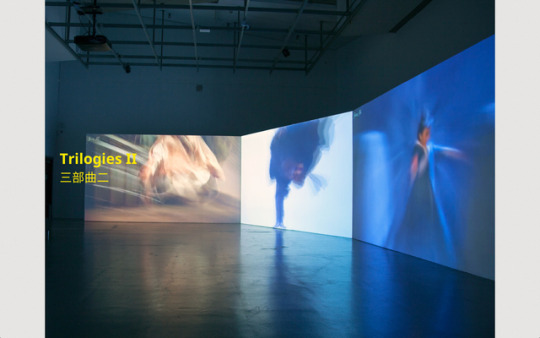
Looking at pictures of the film- it was displayed in three separate frames to be viewed as a single piece- similar to the Way of Ozu by Kogonada. I think this set of three is an excellent way to display dissonate information/clips/imagery. I’m seriously considering trying this for my own work.
Apex- Arthur Jafa- 2013
Apex is a 800+ photo collage of abstract imagery which attempts to share and build on what Jafa considers vocabularies and methods central to black cultural production.

The images play in quick succession accompanied by a beat that matches the cuts between images. This makes the viewing experience rhythmic and mesmerising. The quick cuts allow the film to feel as if it is moving forward and not some much like a slide show which is an interesting effect. I’ve not seen many films made of only still images like this so it was interesting to consider this style as a possibility.

Love is the Message, the Message is Death- Arthur Jafa- 2016
Another of Jafa’s films- this one focusing on a montage of music, video clips and historical recordings to paint a picture of black experience in modern day America.
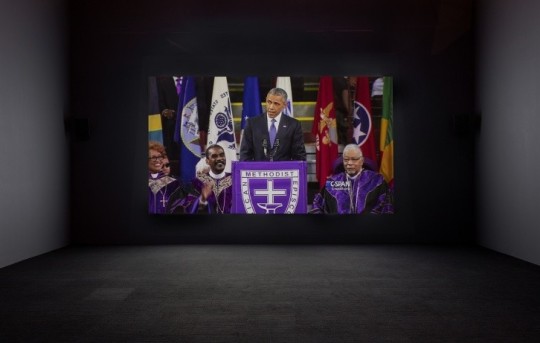
I thought this one was an excellent example of the style of film I want to make- the combination of mute videos overdubbed with a soundtrack, and videos with sound combined with the soundtrack, as well as text on screen really emphasises the montage aspect of the film. I was really inspired by this one and intend to use some of the techniques.
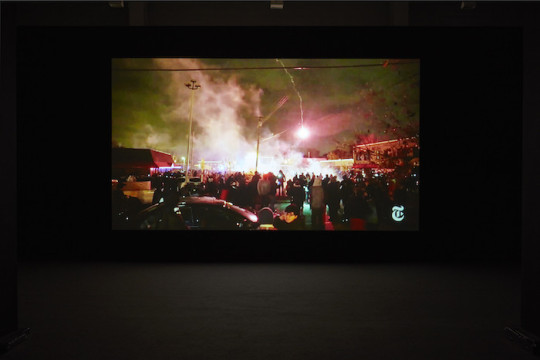
H20- Ralph Steiner- 1929
H20 is a seven minute silent film portraying liquid in various forms. I found it really interesting to sit and watch water in black & white in silence because it almost becomes something else. You can't attach any of the normal sensory attributes to it, and so you notice other things- like tone, reflection and movement.
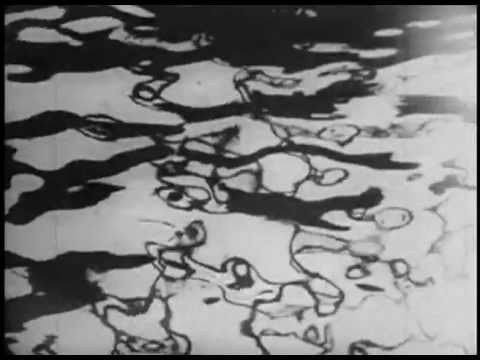
Similarly to mechanical principals, which was made by the same person, I found it useful to consider zooming in on a subject to such an extent that it becomes abstract.

Actuality Picture/ The Magic Lantern- Tom Ireland- 2009-17
This film is 244 minutes long and consists of thousands of images of Saturn taken by the Cassini space probe from 2004 to 2017. The film references early cinema and ‘actuality films’ which documented everyday life.

The images from the space probe allow us to examine a single subject from hundreds of different perspectives, which is very interesting when viewed in quick succession- allowing the viewer to build up a three dimensional awareness of the planet and its surroundings in their minds. I also found it interesting that this film is said to mirror ‘actuality films’ of everyday life- these are image of space- the very opposite of everyday life, and yet they are displayed in so much detail, and in a relevantly mundane fashion, that Saturn somehow becomes everyday!

Dreams Rewired- Manu Luksch- 2015
I have only watched the trailer for this film (its feature length) but am very interested in it and will pursue watching the entire thing soon.
This film uses rare and unseen archival footage from nearly 200 films to create a montage, narrated by Tilda Swinton, to trace the desires and anxieties of todays hyper-connected world/technology.

I absolutely adore the use of interesting/unusual archival footage combined with a modern speculative message which can also be found in the old video material and becomes clear when linked in this way. This is the exact thing I will be trying to do in my own film.
I have become more interested in trying to find some archival footage for my own project after viewing this film trailer.

Arrangement Series- Jin Angdoo- 2013
In Angdoo’s series of arrangement films, objects such as books, cutlery and flowers are arranged, accompanied by classical music, to represent certain moods. The book arrangement below is ‘timid’.

I liked the simplicity and abstraction of the imagery shown in these films- and appreciated the set design which shows the artist is self-aware to the passage of time in her film. I wasn’t sure how I could pally any of these techniques to my own work however.
Miles from Anywhere- Gary Carpenter- 1997
This film, similar to both of the Ralph Steiner films I have already covered, examines surface textures in the extreme close-up. It is an exploration of environment and landscape.

I found this one easier to watch for the modern eye than the similar Ralph Steiner films because of the inclusion of temporally edited music and ambient noise. I found the textures to be hypnotic the way they are run though the film, and thought again, that seemingly ‘boring’ imagery can be brought to live through sound and editing.

Samsara- Ron Fricke- 2011
I watched the ‘food sequence’ clip from the feature length non-narrative documentary film Samsara. The films name means ‘continuous flow’ which sums up the Buddhist belief in birth, life, death and reincarnation.
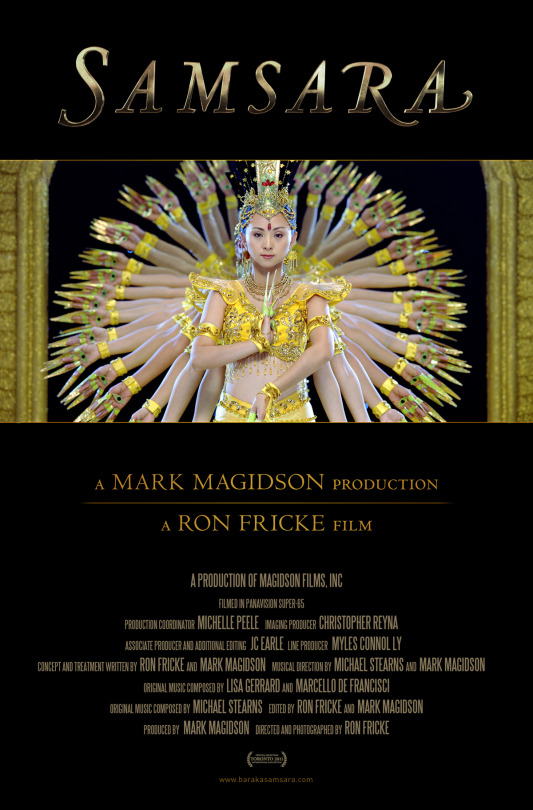
I found the sequence I watched from the film, which focused on food production, specifically the meat industry, and then the consumption of the food, absolutely mesmerising. The clips of the production lines and supermarkets where sped up to show the idea of a ‘continuous flow’ of production, and really made the scale of the human food production industry to clarity.

I thought the order of clips and the pauses between sped up and normal speed ones was particularly effective in allowing the sequence to get points across about what you were seeing without being overtly obvious or needing any narration.

0 notes
Text
140
When’s the last time you saw a rat? A few weeks ago at petsmart Can you see a popular brand logo fro where you are sitting? I can see my nikes, vans, and toms, and I just got Lilly Pulitzer wine glasses for my little for her graduation. And I have some hair products of various brands on my dresser Have you ever had to lead a meeting of any sort? Not a significant meeting. I've "lead" like group meetings for projects in school back in the day What is your ringtone? The generic apple ringtone If given the choice between the escalator and elevator, which would you choose? Escalator What’s your favorite symbol/character associated with Halloween? (Black cats, ghosts, bats, etc) I love black cats they're so cute, I've always wanted a black cat When’s the last time you got a Happy Meal from McDonald’s? It's been years Have you ever been to a bachelor/bachelorette party? I haven't, none of my close friends are engaged yet What was the subject matter of the last email you sent? It was a picture of my time card from temping Do you know someone with the same first name as your middle name? Yes, my aunt. And a few girls in my sorority What’s your favorite gemstone? I like opal Is that also your birthstone? Nope. June has a few different birthstones, and actually moonstone is kind of similar to opal. Alexandrite is another June birthstone that's pretty...I'm just really not into pearl besides like as earrings When’s the last time you tried a new recipe? Not sure, I don't cook much Can you see anything star-shaped near you? No Who’s voice did you last hear? My stepdad Have you ever made a friend through doing surveys? No How often do you use Excel? Since I started temping I use it pretty often...the project I'm doing now has me using excel every day Are you a picky eater? Kind of but I've definitely gotten better in the last few years Favorite thing about the holidays? Family, food, & presents. Was 2016 as bad as everyone says it was? It definitely had its ups and downs Does your best friend have a survey blog? I doubt it haha Have you ever played Pretend You’re Xyzzy (Cards Against Humanity online)? I tried to once and it wouldn't work What are your favorite things to put in a salad? I've been diy-ing Panera's Fuji apple chicken salad and it's the bomb...I do mixed greens, red onion, cucumber, green apple, pecans, feta, and the most amazing part is that target sells bottled Panera dressing! And it tastes just like the Fuji apple dressing when I get it at Panera. But I like my version of the salad better it's just so delicious. I would add chicken but I make this to take to work and don't have time for all that so yeah Have you tried the Starbucks Pink Drink? What about the Unicorn Frappuccino? No x2. I'd like to try the pink drink, looks tasty. And I haven't heard great things about the unicorn frapp, plus it's supposed to have like 2 days worth of sugar servings, which um no thanks Favorite Belcher family member (from Bob’s Burgers)? I've never watched bobs burgers tbh. And now there's apparently limited episodes on Netflix so who knows if I ever will Do you like the movie Clueless? It's a classic Do you have any Post-It notes stuck to your computer? Nope When’s the last time someone used your name? Earlier today talking to a "co worker"...in quotes since I don't really work there like I'm only there for a week or two more Favorite internet meme cat? Is keyboard cat considered a meme? I always liked keyboard cat Do you have an iPad or tablet? Yep When ordering take out, what is usually your meat of choice? We only really get takeout from an Italian place, and I get pasta. If I get Thai, I'll usually get chicken When is the last time you went swimming? Like September maybe Any short-term goals? Start drinking more water. Work out (almost) every day. Ice tea: Sweetened or Unsweetened? Sweet What is your favorite color and what is the closest thing to you in that color? Light minty blue, which my sheets and my walls are kind of different variations of that When’s the next time you’re going out of town? Technically tomorrow for my temp job. I'm going to an amusement park on Saturday so then like for fun purposes What is your Facebook cover photo? A group shot of me and some friends from srat formal last spring Favorite Friends episode? I think I've answered this before and said the "he's her lobster" one where Ross and Rachel first kinda get together. And I also may have said the one where Ross plays the keyboard and sucks. And I still stand by those, but I'm gonna add the one where Ross keeps fucking up his spray tan
1 note
·
View note
Text
EMP Theory from HLV to TLD
Here’s my big write-up on what I think is going on if EMP theory (extended mind palace theory) is correct. I’m not totally sold on it, but I’m even less sold on every other theory I’ve heard, so I’m going to just make the most solid case I can.
Feel free to raise objections, ask questions, contribute additional evidence, or point me toward metas you’ve already written on points I bring up. Please note that I really suck at keeping up with responses and such, though, so anyone who reads this should also trawl the notes.
Note about the BFI screening:
Note that I think the early screenings of TFP are fake versions made to protect their secret reveals and to play upon the alternate endings of the movie Clue, so please do not dismiss this theory because of “spoilers” you may have heard.
If EMP theory is real it is integral to the Johnlock reveal, so they would not reveal it in a screening. Same goes for things like Mary being alive, Moriarty possibly being alive, Rosie never having been born; those are all contingent on EMP theory. Any fake version of TFP would have to keep Mary and Moriarty dead, Rosie alive, etc.
I saw the Russian screener and it only makes me feel that EMP theory is more likely.
There was nothing in the version of TFP that was screened that explains any of the weirdness in T6T or TLD via any other competing theory. So you either have to believe that they’ll never explain it at all, or they’re going to reveal some explanation only when it officially airs on Sunday -- in which case you may as well consider EMP theory.
If they’re not doing EMP theory, I feel they would have had to have filmed a lot more extra footage to explain things via a different theory, but who knows. The Russian screener contained a lot of scenes that would be great prior to an EMP reveal.
Table of Contents
Background on EMP Theory
Why Our Dads Would Totally Do EMP Even If You Wouldn’t
Why EMP Would Not Suck or Be Cheap or Whatever
My Take on EMP Theory
1. Background on EMP Theory
EMP theory is the idea that starting around the time Sherlock gets shot in HLV and all the way through at least the beginning of TFP (we’ll have to see), the scenes are actually in Sherlock’s mind while he’s in the hospital.
Please note that theory does NOT originate with me as I wasn’t really aware it existed until well after I deleted in February 2016, I’m just way up its ass since T6T aired and watching S4 thus far has felt like a fucking LSD trip. The origins of the theory are explained here in the EMP theory masterlist compiled by @monikakrasnorada. Quote:
The term “EMP” was coined early in January 2016 in a discussion just after the airing of The Abominable Bride between @the-7-percent-solution, @gosherlocked and myself. This discussion entailed trying to understand / decipher which “present day” scenes in TAB were real which then snowballed into the possibility that perhaps more of His Last Vow might have taken place in mind palace as well. So, a theory was born!
Other contributors on that page are @isitandwonder, @ebaeschnbliah, and @tjlcisthenewsexy. Additional people whose metas or comments got my attention after T6T aired and made me reconsider EMP theory are @impatient14 and @doomsteady.
I’ll reference specific metas as I go, but please let me know if I make an argument and don’t reference someone who worked on that argument already; there’s tens of thousands of people in the community, and it seems like most of the hundred blogs I follow have been hitting the post limit daily since T6T aired so my dash is overloaded, and I have been utterly unable to keep up with my mentions and asks. Given that the basic idea behind the theory is pretty simple to grasp, I’m sure I’m going to run into the same ideas others have via convergent theorizing. Also, this has been brain-frying to write, what with juggling images and links, so I may have omitted some people on accident; just correct me. I’m not trying to take credit for anyone’s ideas and I’m totally happy to link to anything others have written before this.
There are several ideas about when EMP kicks in, but I’ve settled on the one that seems most damning to me. But before we get to that, let’s get a few things out of the way first.
2. Why Our Dads Would Totally Do EMP Even If You Wouldn’t
Well, the fact that they did The Abominable Bride is pretty good evidence.
But honestly, if you haven’t already, stop and read this meta I wrote about the parallels between Sherlock and the movie What Dreams May Come, which is about the protagonist dying, his spouse killing herself in her grief, and the protagonist going to hell to save his spouse. I’m going to argue that what’s going on in S4 is that Sherlock begins sensing from within his coma that if he dies John will kill himself, so Sherlock must return to consciousness.
There are TONS of very specific things borrowed from What Dreams May Come discussed in that meta, including:
the promo imagery of water and the hole in 221b’s wall
the entire concept of John’s therapist telling him that writing a blog will make him feel better when it’s really just being with Sherlock that makes him feel better
the protagonist remembers a dog being put down while he’s dying, and his old dog licks his face when he’s in heaven
the protagonist jumps off a waterfall to get to his spouse
the protagonist can sort of hear his anguished spouse while he’s dead and she’s alive; it bleeds through into his world
the protagonist is creating everything around him in his own mind
the idea of characters masquerading as other characters and saying things those characters would say
the idea that suicidal people punish themselves in their own mind
the protagonist has to understand that he’s more than just a brain
dying forces the protagonist to get over his fears
going through hell involves confronting terrible memories
time is weird and dreamlike when you’re dead
Seriously, READ. IT.
Past that, have you ever seen Doctor Who? While it doesn’t mean they are doing EMP, Doctor Who is the biggest reason why “they wouldn’t do it” is simply wrong: Our dads grew up with crazy shit and write crazy shit on the regular. There are episodes of Doctor Who with all sorts of fake shit, including one that’s really similar to the movie Inception, a movie about dreams within dreams. People scream and complain about Doctor Who ALL THE TIME, believe me, there’s always people saying everything they do is dumb and cheap, but our dads don’t give a fuck. Remember, they just write the sort of thing they want to read/watch.
And what kind of stuff do they like to read and watch? Just like What Dreams May Come, this comes via @skulls-and-tea:
Tom’s Midnight Garden. It’s about slipping in and out of the Victorian era. Moffat says, “I love that book, and I’ve been remaking it ever since.” But we could argue he already did this with TAB and Doctor Who, sure.
Other notable influences on our dads that don’t necessarily have to point to EMP theory specifically (again, thanks to @skulls-and-tea): Alice in Wonderland, The Wizard of Oz, H.G. Wells, Agatha Christie does a lot of unreliable narrator stuff, etc.
But the point is they’re VERY into these weird types of stories, so just because you aren’t, that’s no reason to think they wouldn’t do it. Also, a lot of people really like EMP theory and also grew up with weird stories like this -- like me, for example -- so remember that just like anyone else with particular tastes, our dads know other people with similar tastes exist, they wish more stories catered to their tastes, and it’s feasible they would want to write those stories.
Remember: If they cared very much about alienating people they wouldn’t make a gay Sherlock Holmes adaptation. And their Doctor Who stuff already does stuff similar to EMP.
I also went into a lot of depth about our dads’ twisting of genre conventions, and how it’s necessary in the mystery genre to stay ahead of the reader/viewer, in this meta. When you’ve had a century-long genre convention arms race to keep fooling audiences, you have to do crazier and crazier shit to keep from being too simple. S4 has really proved that so far. And the biggest fucking rug pull in the world would be telling mystery viewers that they missed the point in the story where everything went all fake.
Come on, that’d be fucking hilarious. Do you know how much trouble I had writing M-theory after the point where Mary shot Sherlock? SO MUCH TROUBLE. Everything just stops making sense at that point. And if EMP theory is real there ARE clues there in HLV, so I couldn’t say it wasn’t fair. It would be so funny. Soooo fucking funny. I and so many other people will have spent so much time trying to rationalize things that simply don’t make sense. I would never feel more honored to get jerked around by the author-god in my life.
If ANYONE IN THE WORLD would have the gall to pull “it was all a dream” on such a high profile show, IT IS OUR FATHERS. That is EXACTLY the sort of shit where they’d be like, “You know how you could do this bullshit right...? If the fake scenes actually advanced character development and ended up being important to the plot.”
3. Why EMP Would Not Suck or Be Cheap or Whatever
My biggest reservation about EMP was that it would be unsatisfying, so when I glanced at it in early December I didn’t really dig very deeply. But now that I have, I don’t feel that way at all. I think it would be really cool and fulfilling!
Sherlock didn’t get played by Mary, he just got played by his own mind choosing over and over to be a good, selfless person!
John was never so indifferent to Sherlock! He’s been at his bedside the whole time! He never just forgave Mary for shooting him! When Mary supposedly died and John said, “don’t you dare, you took a vow, you swore it” he may have actually said it to Sherlock when Sherlock appeared to be dying in the hospital. John never beat the shit out of Sherlock in TLD, it was just Sherlock’s brain punishing himself!
Mycroft wasn’t so weirdly idle about Sherlock being shot! Mycroft didn’t hold back tons of info about Mary just to reveal it later like it wasn’t so important a secret anyway! He didn’t act so amused by Sherlock’s investigation and seem so pleased with himself for giving Sherlock mere crumbs!
It could all be setting up the casuals to feel that everything is off and doesn’t make sense, so when the rug is pulled and it turns out John actually raised hell about Sherlock getting shot and Mycroft wasn’t useless, they’ll be like “THANK GOD YES THIS MAKES WAY MORE SENSE.” And they’ll totally want Sherlock to end up with John because they’ll have just seen Sherlock mentally torture himself trying to make sure John is happy. That beautifully aligns with the BBC LGB report’s goal of showing homophobes that queer love is compatible with their values.
Furthermore, character development still happened! Most “it was just a dream” stories suck because they’re just a big unplanned reset button, but this wouldn’t be. It would only retcon stuff like Mary being a saint and Sherlock being an idiot and John being an asshole. Y’all would miss that stuff and grumble about it being fake? Really? I mean I’ll accept it if it doesn’t get retconned, sure, but come on. Sherlock’s the character who’s been growing all these episodes and he’ll get to keep that growth. The plot will require that growth going forward.
And unlike most “it was just a dream stories,” it lays a lot of important foundation for what happens going forward: Sherlock has been going deep into his own head, confronting a bunch of fears and repressed memories, and sorting himself out to be a better person for John. We just had whole episodes of how much Sherlock’s stupid little heart and brain will twist themselves in knots to do right by John. We just got shloads of evidence that Sherlock is NOT a sociopath, and is in fact ungodly levels of selfless when it comes to John. They showed us that Sherlock is willing to lose John and just be massively depressed if that’s what’s best for John. Come on.
Plus, not necessarily every bit of plot was fake. We know from TAB that the different levels of mind palace can bleed together, so Sherlock may be overhearing things said in his hospital room and incorporating them.
Some people feel like we’d have been in Sherlock’s mind for too many episodes, but look at it this way: TAB wasn’t supposed to happen at all, it was just an extra episode they gave us because they like us, and it was actually full of clues that help us figure out T6T and TLD are fake. It also reassured us of the arc the story is taking with the waterfall scene. It was fun and still relevant to the game, and I don’t have it in me to complain about something so amazing. Y’all are gonna complain we got several episodes just for us, episodes they knew only we could untangle?
Furthermore, I personally would love to know we’ve been in Sherlock’s head this whole time because it tells us so much more about Sherlock’s character than we’d ever get to see otherwise. His mind and emotional issues are complicated enough that I would expect it to take a multiple episode journey to sort it out.
Finally, just from what I’ve observed about alternate theories for what’s going on in T6T and TLD, it seems like most of y’all want the most important parts of T6T and TLD to be fake anyway. Most people don’t like Mary being good, John blaming Sherlock for Mary’s death, John beating the shit out of Sherlock, John cheating with some rando instead of texting Sherlock, etc. Y’all were willing to throw that stuff under the bus for something like alibi theory or drugs theory or an unreliable narrator, but suddenly the little details are sacred and it would be cheap if those were fake too?
Come on. Give EMP a chance.
4. My Take on EMP Theory
His Last Vow
There are a few ideas about when EMP begins. For example, when Sherlock gets shot, or when the ambulance comes to get him at 221b, or even just after he gets on the plane. However, there’s one scene that stands out to me as the most likely entry point.
Just after Mary threatens Sherlock in the hospital, we get the scene with Janine. She notes at the end of the scene that she’ll give Sherlock’s love to John and Mary, which implies that Sherlock has not yet been conscious when John is in the room. And that makes sense, because we didn’t get any scene where John asks who shot him and Sherlock tries to hide the fact that it was Mary or anything. When John and everyone are trying to find Sherlock, John even wonders aloud why Sherlock would protect his shooter, as if that question is a new development.
All evidence suggests that Sherlock did not get to have a conscious off-camera visit with John in the hospital; John just hears Sherlock say, “Mary,” when Sherlock is barely conscious.
In other words, it appears that Janine is the first person Sherlock is awake to talk to.
Janine (who I suggest is working for Moriarty, or is his sister, in M-theory) added something to Sherlock’s IV when he was unconscious; she admits she “fiddled with the taps” and that it must be a “dream” for Sherlock to have drugs hooked up to him.
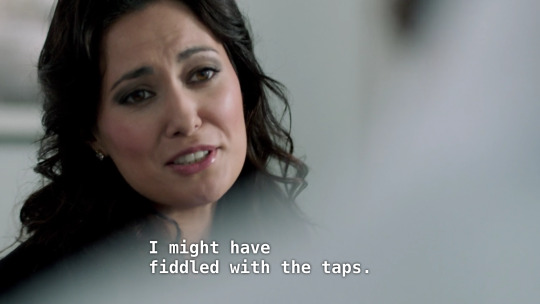
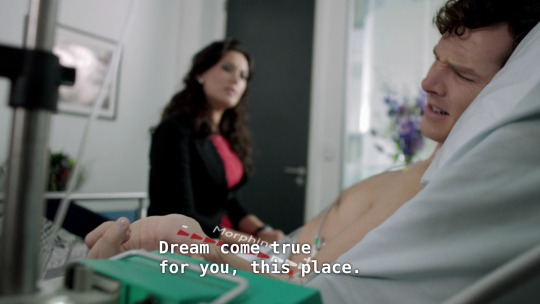
Sherlock turns the “morphine” back up during her visit, but turns it down to a trickle -- not off entirely -- when Janine leaves. Sherlock got a decent dose of whatever was in the IV while Janine was there.
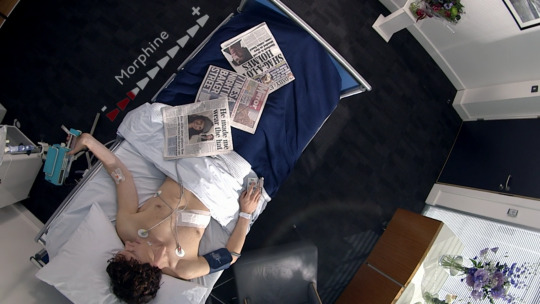
Sherlock then has his “Mary Watson” mind palace sequence. We’re lead to believe he comes out of it and flees the hospital, but our big clue that he’s actually going deeper into his mind palace is that his heart monitor suddenly runs backwards after running forwards the whole scene with Janine (credit to @yan-yae for the find and @doomsteady for the gifs, both at the link).
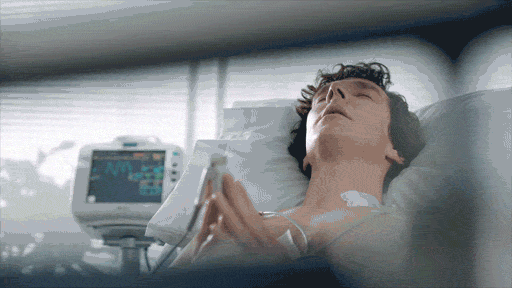
That is a REALLY weird thing for them to have done. Surely they were able to take enough footage of Benedict doing whatever they needed; lying in a bed looking pensive for five seconds is well within his acting range. So why did they reverse it?
Here’s what happens when you reverse it back, so it’s going forward properly:
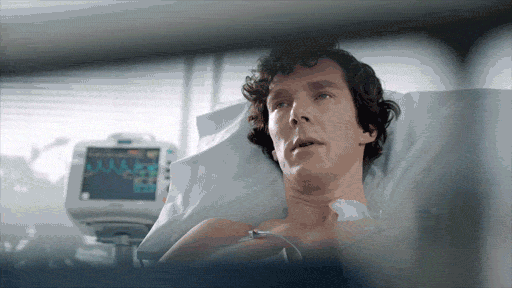
He goes deeper into his mind palace. Dude is on drugs and in his mind palace. We’ll see further evidence of this scenario having taken place in T6T and TLD.
Furthermore, check out this weird bit of an interview @skulls-and-tea found. Our dads almost never interject to provide extra information to an interviewer, but they wanted to make very clear that Sherlock’s mind palace alone does not create elaborate scenarios, just his mind on drugs does that:
INTERVIEWER: You could go back to Victorian London; you could have more things set in [Sherlock’s] Mind Palace where he’s going back–
GATISS: [interrupting] Well remember – it’s not just his Mind Palace [in TAB].
Mycroft says it explicitly – ‘It’s a memory technique.’
In both occasions where we’ve gone into it – in ‘His Last Vow’ he’s been shot, and he’s obviously doped to the eyeballs.
And in ‘The Abominable Bride’, he’s all – he’s high.
So it’s much – it’s a particular thing.
We could do it [go back to the Victorian setting] of course, but he’d have to… take a seven-percent solution. Or more.
They could have easily just gone along with the interview and said sure, maybe they’ll do something like TAB again one day, whatever. Instead, Gatiss gave the impression that mind palace drug mechanics are particular and important.
Back to Sherlock’s mind palace deduction about Mary being a liar.
In M-theory, I said that Sherlock’s epiphany about Mary may have been that she could be working for Moriarty: saying “Mary Watson” aloud makes him think of “marry Watson,” a command rather than a name, and the gunshot sequence at the end reminds him that Moriarty had left a sniper on John. He also imagines Mary doing the head tilt that Moriarty is known for.
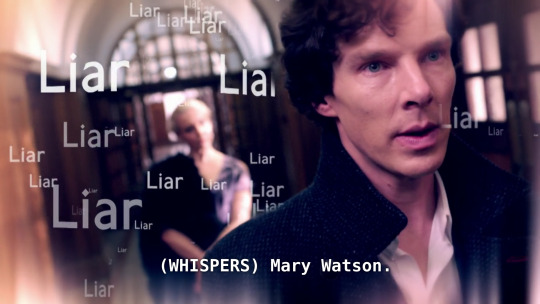
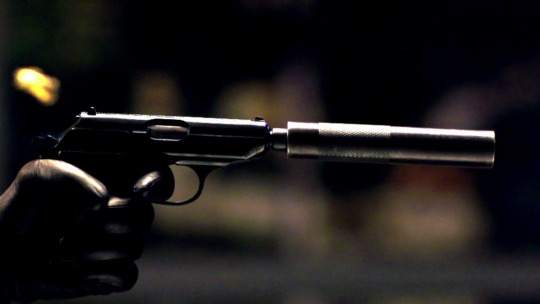
If that’s how Sherlock interpreted things, it would certainly explain why he recently had Moriarty in his mind telling him that “John Watson is definitely in danger.” The whole reason that Sherlock came back to life was to save John, remember? If this sequence isn’t about a potential Moriarty connection or at least Mary being a threat, it’s weird for Sherlock to act as if he has any new startling information about Mary after this deduction; it’s weird that the sequence was necessary at all.
Mary is very ominous in his mind palace, so why does he roll over for her so fast once he leaves the hospital?
One reason why EMP theory makes more sense to me than any alternative is that it’s absolutely nuts that a non-drugged Sherlock wouldn’t immediately suspect that Mary was one of Moriarty’s snipers. We know from TEH and HLV that Sherlock has been trying to figure out who put John in the bonfire, and that he must be concerned that he didn’t take out all of Moriarty’s network given that John was kidnapped the day after Sherlock came back to life. Sherlock’s thought processes seem to make sense up until this deduction, but then they get clouded.
Also note that it makes sense that Moriarty would want to drug Sherlock and fuck with his mind, just in general. We may have gotten some foreshadowing toward the end of THoB, when Sherlock sees Moriarty’s face in association with the fear gas:
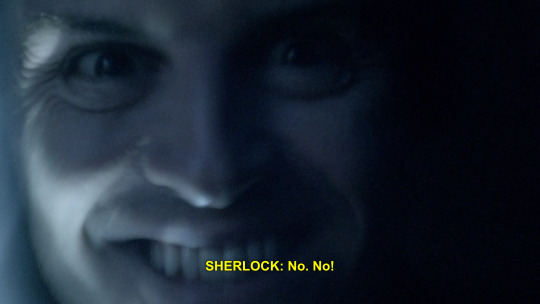
Anyway, things get strange after this scene because Sherlock is imagining it all. He’s been drugged so he can’t actually go after Mary. Instead, he’s stuck trying to figure out what may be going on with Mary, and his brain has to make it up. Remember, we’ll see in The Abominable Bride that Sherlock is capable of making up multiple characters with multiple motivations that change as he considers them. We see Sherlock imagine full scenes among characters in TAB when Sherlock isn’t even present for the scenes. We see Sherlock make up entirely new people he’s never met before.
There’s no way to tell a drugged mind palace episode from a real episode except that drugged mind palace episodes wouldn’t make total sense, just like TAB.
Without actual evidence about Mary’s past, emotions start clouding Sherlock’s judgment because there’s several things Sherlock doesn’t want to believe:
That Mary, his friend, could want to kill him.
That Mary could have so thoroughly fooled him.
That Sherlock wasn’t thorough enough in taking out Moriarty’s network, and his negligence left John in danger.
That Moriarty would be insane enough to have some kind of posthumous revenge.
That Moriarty could still be alive.
That someone could marry John and not really love and appreciate him etc.
It’s also possible that Moriarty has agents like Janine or Mary whispering weird shit to him in his drugged state to influence his thoughts; we’ll see some evidence of this idea, and the idea of the real world bleeding through to Sherlock’s mind palace, later.
So Sherlock imagines that all the following are possible for someone who’s just fled a hospital room after nearly dying of a shot to the heart:
escaping through a window several floors up
contacting Anderson with his real location, because everyone would be looking for him, including Mary
moving John’s chair back into its usual position in 221b
acquiring a bottle of Claire de la Lune and putting it in 221b
getting a spare cell phone for Wiggins to hand to Mary
getting Wiggins in position
setting up a projector with Mary’s picture on it
getting to Leinster Gardens
getting John to Leinster Gardens and in position
That’s a lot to swallow if it’s real.
When Sherlock puts up the projection of Mary on the outside of Leinster Gardens, he says, “I never could resist a touch of drama.” He’s going to say this in two more scenes later, one that we know is fake and one that we’re not sure about. (Credit to @1895 for the gif, at the link.) What reason is there for the repetition, why link the scenes that way? EMP theory says it’s because they’re all fake.
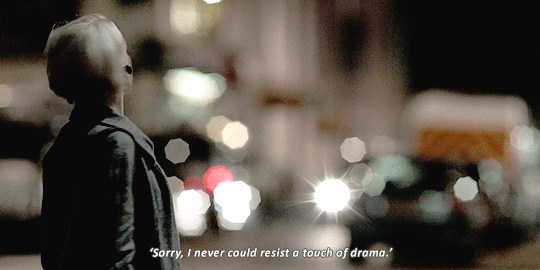
Sherlock dictates aloud a backstory for Mary based on what little he does know about her. He imagines the name Mary Morstan came from a stillborn because Jennifer Wilson, whose body he found at Lauriston Gardens on his first case with John, had a stillborn daughter and a pink coat similar to one of Mary’s coats, and the location names are similar. Sherlock’s mind obsessing over the first case with John is going to be a recurring theme.
But Sherlock can’t infer nearly enough about Mary to be sure that she’s working for Moriarty, so his brain tries to reassure him she’s not that bad:
Mary’s an excellent shot, yet Sherlock lived, so she must have meant to not kill him.
If Mary didn’t mean to kill him, she must have been buying time somehow.
For Mary to go to those lengths, it must be because she just loves John so much and wants to keep him forever and ever. It’s not exactly difficult for Sherlock to imagine someone loving John so much they’d kill for him; he imagines himself killing CAM for John at Appledore later.
If Mary loves John that much, she’s not a danger to John.
Once Sherlock’s brain decides that must be the case, he decides he has to do right by John: he wants John to have a chance at life with Mary if that’s what John really wants, which is John’s decision; and even if they break up Sherlock still has to save Mary to save John’s unborn child. So he tells them they’re going to have to talk it out.
Time starts jumping around here because it’s all in Sherlock’s head: he’s trying to construct a narrative of how he could save Mary at the same time he’s trying to figure out what Mary’s true past could possibly be.
If that seems nuts, remember that you already accept this degree of detail and time slips are possible in Sherlock’s mind: we have it confirmed in The Abominable Bride that when Sherlock is drugged up, his mind palace is crazy realistic. It’s not full of wish fulfillment and total nonsense or anything like a typical person’s might be, rather, it’s full of his fears, like John and Mycroft giving him shit.
Think about it. Why did we never get a moving scene of John at Sherlock’s bedside, or Mycroft visiting the hospital at all? Sherlock is stuck in his own mind, where he only partially understands how important he is to them.
When the Watsons have their domestic in 221b, Sherlock’s mind doesn’t have the information to expose Mary’s real backstory. So what does his mind do? It tells him that information is all on a memory stick he can’t read. That’s why we never see any scene of Sherlock reading the memory stick, even though realistically he would. It’s also why he imagines John forgiving Mary without having read the memory stick; that way they don’t discuss it and Sherlock’s brain doesn’t have to fill in information it doesn’t have. Then, since it makes no sense for John “Trust Issues” Watson to not have read the stick, Sherlock decides it must just take John months to forgive Mary.
It’s all dream logic, where you rationalize how things could be happening after the fact.
Why does Sherlock imagine John forgives Mary? Sherlock says it himself in the domestic in 221b scene: John “chose” Mary because she, just like Sherlock, is what John likes. My read of The Empty Hearse and The Sign of Three is that Sherlock is confused over why John won’t pick him over Mary, and Sherlock answers his confusion in that scene: John finally found a female version of Sherlock.
Sherlock also decides that Mary actually likes him; he claims it’s “sentiment” that made Mary “save [his] life.” But how do we know Sherlock’s memory here is inaccurate?
Here’s what CAM says in the actual shooting scene:
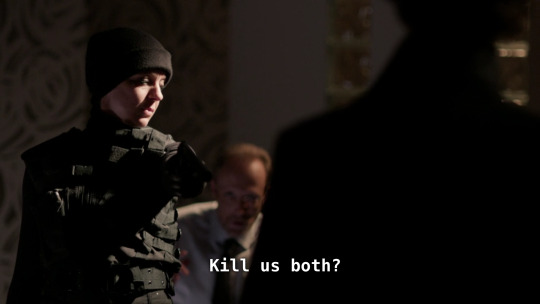
But how does Sherlock remember it?
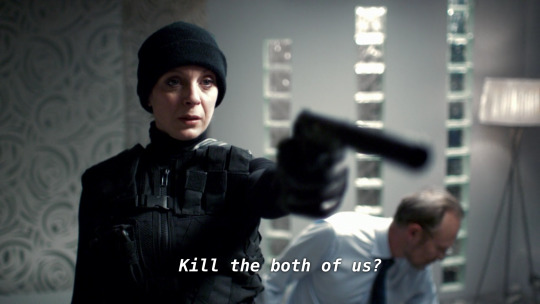
Sherlock also imagines that Mary called the ambulance, when the original footage seems to indicate that it was actually CAM; Sherlock was dealing with dying at the time, so of course he doesn’t know any better. [The link is from @reminderofwhereicanfindher, but I have actually seen several metas point these things out over the years. If you want yours credited, just tell me.]
Sherlock knows that Mary must have been threatening CAM over blackmail material about her past, and decides the next step is to go retrieve it: maybe there’s things in her past that would sway John back to choosing him, but if not, he still needs to save John’s pregnant wife. So he imagines making a deal with Magnussen... in a totally weird, dreamlike setting:
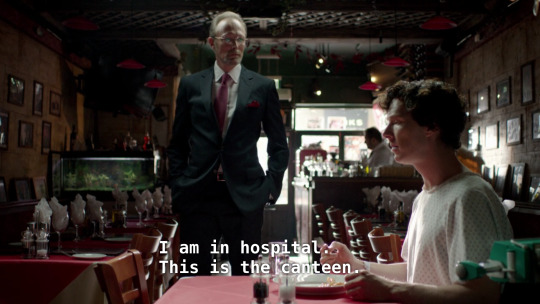
Sure, Sherlock does weird shit; plenty of these scenes could be real, but if they’re fake, they’re good tricks because Sherlock is such a drama queen we just buy it.
But he chooses to leave for a more dignified setting and doesn’t change his clothes? He supposedly set up the whole Leinster Gardens scene earlier but half-asses his meeting with CAM? Furthermore, if CAM really came to threaten him in the hospital like the deleted scene suggests, why didn’t he just get CAM to come to the hospital?
Furthermore, why does Sherlock never seem to go to Mycroft -- even and especially because it’s later supposedly revealed that Mary has been working for Mycroft? Well, Mycroft knows everything and that’s how Sherlock generally perceives him, but the Mycroft in Sherlock’s mind can’t fill in information that Sherlock doesn’t know, so he doesn’t go to Mycroft yet. It’s the memory stick all over again.
So Sherlock goes on to imagine this elaborate plot to visit Appledore. The first sign that it’s all fake is that this time around, unlike at 221b earlier, CAM’s goons don’t check John and Sherlock for weapons.
Once Sherlock is at Appledore, Sherlock's mind hits a wall yet again: he’s expecting CAM to reveal Mary’s past, except Sherlock’s mind still can’t fill in that information. So what does it do instead? He imagines that if CAM doesn’t have physical records of his blackmail materials, or electronic records, that leaves only one thing: a mind palace, just like Sherlock’s.
Of course, we allegedly saw CAM’s “mind palace” at the end of The Empty Hearse and the beginning of His Last Vow. But was that a mind palace? We see CAM looking at real video footage of Sherlock pulling John from the fire in TEH; that had to actually exist in order to get back to CAM, and he even shows them the video when they visit. In other words, CAM does have vaults. And of course he does, because when CAM visited 221b he had physical copies of the letters Lady Smallwood’s husband wrote. If CAM wanted to print a story about Lady Smallwood’s husband, he would probably want that picture of Helen Catherine Driscoll he was looking at, and so on. Surely CAM has to sometimes trade proof of things in order to get what he wants from people. He keeps hard copies of things somewhere.
But Sherlock’s mind writes him into a corner where it must be a mind palace, so he imagines killing CAM to save John and Mary both, securing John’s domestic future. Sherlock can’t ever resist a touch of the dramatic, after all.
Sherlock imagines Mycroft making his case to his colleagues, and imagines Mycroft mentioning “The Other One,” a sibling whose memory Sherlock has repressed because something bad happened to them and part of Sherlock’s mind connects that to his own life taking a doomed twist. Mycroft being the one to drudge up these memories of The Other One will come up again later.
Side theory: Euros is just Sherlock
It doesn’t really matter, but with EMP theory it’s actually possible that Sherlock has splintered memories of himself into the idea of a secret sibling that his subconscious keeps trying to make him remember via his projection of Mycroft. Remember, we don’t get ANY mention of “the other one” until Sherlock is already trapped in his own mind. This seems way more likely to me than Sherlock having a sister who’s nuts.
Consider: Something bad happened and Sherlock went nuts -- and felt that Mycroft did not display enough concern for him after it, apparently -- then Sherlock buried it all. I get the vibe from Sherlock blaming himself unfairly for Mary’s death that maybe Sherlock blames himself for Redbeard’s death or something.
We get crazy Euros stuff later, but we know that Sherlock has a memory of being terrified in a padded cell to draw upon for his death mind palace. So either both Sherlock and Euros ended up terrified in a padded cell, or something fucky is going on.
It seems possible that Euros is a part of Sherlock’s psyche that Sherlock needs to integrate; otherwise she’s kind of a ridiculous character, even for this show. I mean, Mycroft doesn’t want Sherlock to remember Euros... yet he spent years terrifying Sherlock with stories of Euros’s name -- “the East Wind is coming to get you?” That’s a nonsense strategy, to say the least.
But Sherlock locking up his worst memory by labeling it with a concept that scares him away? That seems more likely to me.
Plus, remember in TEH that Mycroft says they both thought Sherlock was stupid until they met other children. Maybe Mycroft’s just politely omitting the crazy sister that Sherlock is too traumatized to remember, or maybe Sherlock’s psyche got fractured prior to being institutionalized at some point in his life. Maybe part of being stuck in his own brain for several episodes is about integrating the sentiment-driven part of himself that got damaged by something traumatic.
Guess we’ll see.
Back to HLV:
Sherlock imagines saying goodbye to John. He imagines John not seeming to care as much as we’d expect. ‘Cause it’s fake.
Sherlock doesn’t tell John how he feels on the tarmac, which through the lens of EMP theory as I see it is because Sherlock’s not yet emotionally developed enough to do so. Remember, Sherlock’s arc is about going from being a great man to a good one. The ensuing episodes are about having Sherlock work out his shit so he’s truly ready for a relationship, and isn’t just the same guy from The Empty Hearse who falls back on humor when he can’t make himself say the things he wants to say. He’ll be realizing that he’s willing to make any sacrifice for love.
On the plane, Sherlock broods over the time he and John met by reading John’s blog (which we can bet Sherlock pretty much has memorized). But as he flies away, something still doesn’t feel right to Sherlock. He and John still don’t know anything about Mary’s past. Something feels very off.
Sherlock feels very weird, like he’s drugged.
Something feels very Moriarty. Wasn’t he worried about Moriarty earlier?
Sherlock’s mind decides that Moriarty must be back. But that’s not possible... is it?
The Abominable Bride
Sherlock is still in the hospital being drugged, but imagines that he’s in Victorian London and meeting John there instead -- because the part of his brain that knows all the gay history referenced in TAB is feeling pretty closeted.
When he later realizes he’s not really in Victorian London, his brain justifies the drugged feeling by deciding he must have purposely taken a bunch of drugs.
I said this earlier but I’ll repeat it anyway:
Note that the first scenes of TAB are about John only, so we know that just because Sherlock isn’t in a scene, it doesn’t mean he’s not imagining it. We see full scenes without Sherlock continually this episode.
Also note that here we get the A Study in Scarlet (Arthur Conan Doyle) version of their meeting. This is important to remember, because the backlit skull in T6T is covered with the text of it.
TAB is where loads of continuity errors start to kick in.
First things first, we’ve got what @skulls-and-tea called “tie hell:” Mycroft’s tie changes from HLV to TAB (credit to Skully for the close-ups):

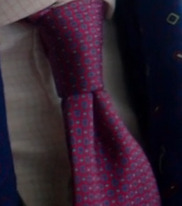
Okay okay, maybe there was a fuck-up with the wardrobe. Kind of unlikely for this show, given how carefully they do manage everything, but no one’s perfect, right?
But @skulls-and-tea also realized that six months before TAB aired, Mark said this when asked about a fandom theory that existed beforehand that there’s some kind of code to the ties they use:
“There’s nothing, there’s no tie code. No tie code. Sorry! I wish we’d been that clever, but we haven’t.”
Of course they would lie if there was a tie code, so that’s not what’s meaningful here. What’s meaningful is that they already knew the fandom was looking for codes in the ties, thought it was a clever idea they wished they’d used, then fucked up Mycroft’s tie in TAB even though that would make us think something was amiss. TAB was conceived after TJLC was in full force; they’d written the episode for us, the people who pick the show apart more than anyone. Why would they be so careless with the tie?
They weren’t careless: they want us to think something is amiss.
Furthermore, the plane interior in TAB isn’t the same as it was in HLV, and @gosherlocked wrote up a fantastic overview of tweets from set director Arwel Jones and director Douglas Mackinnon explicitly confirming that the differences are intentional because maybe the plane is in Sherlock’s imagination.
Even without that confirmation, there’s good reason to think the “real life” scenes of TAB are all fake... except for a small part of the one real life scene that is revealed to be fake. Which is hilarious, come on.
First of all, Sherlock looks surprised to see the pilot, as his brain had made her into Lady Carmichael. Presumably he’d seen her earlier and incorporated it. But wait a minute... if he’d seen her earlier, would he be quite so surprised to see her now?
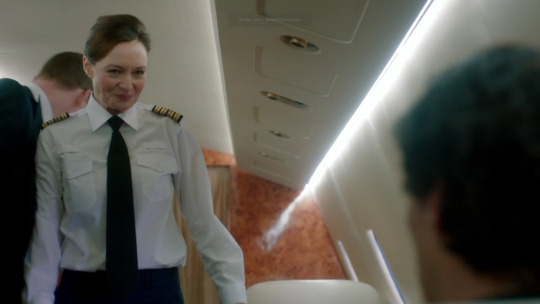
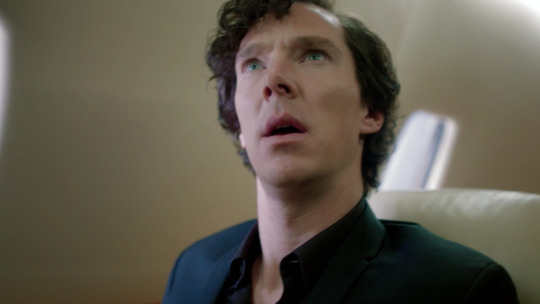
We assume that he just didn’t really consciously see her earlier, that he’s drugged up and that’s why he looks startled. But what if Sherlock made her up entirely -- what if he stole her from his Victorian mind palace for his “real life” mind palace first?
And isn’t it kind of weird that in a scene we supposedly know to be fake, Sherlock imagines he’s in the hospital? With John and Mycroft there, just like we’d expected to see in HLV?
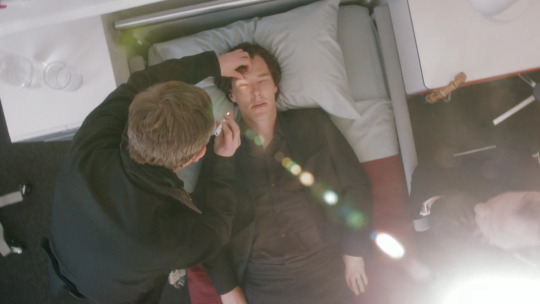
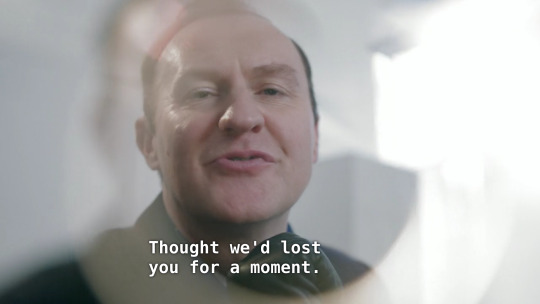
We also get this possible nod to EMP -- though it works without EMP too, just like the episode, which is why I think it’s genius:
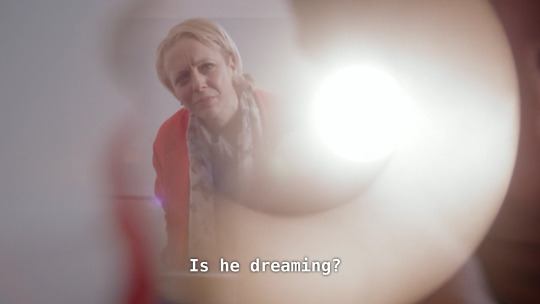
Then the grave-digging scene that follows is proof that “real life” scenes may look entirely convincing without being real at all. Again, you already accept that if we were seeing a lie, we wouldn’t necessarily think anything was amiss until the rug is pulled! Unless, you know, the things going on in the scene felt ridiculous, like the the grave-digging one.
Given that we see Sherlock incorporate things from the “real life” level into his Victorian mind palace during this episode -- such as modern John bleeding through into Victorian Watson -- there’s no solid reason to believe that the few bits of people looking over him in a hospital bed aren’t real, even if the grave-digging bits are imagined. Dude is drugged out of his mind.
But there’s also some important stuff we’ve got to cover even in the obviously imaginary parts of TAB. Some of it reinforces that the parts of HLV we covered are fake, and some of it reinforces that S4 is wholly fake.
Early on in TAB, Sherlock’s mind realizes that everything is really weird. It’s clear from Sherlock’s real life observations that John isn’t actually that into Mary, no matter what reconciliation Sherlock imagined. Sherlock’s fears made him think that John chose Mary because she ticks the same boxes that Sherlock does and John simply prefers her, but Sherlock’s mind just can’t seem to uphold that fiction when he goes through the evidence: in TAB, Sherlock’s brain repeatedly recognizes that John would rather go off on cases with him than hang out with Mary. In the beginning Sherlock tells himself that John is only hanging out with him because John likes the fame and attention that writing about Sherlock attracts, but once Sherlock winds up at the waterfall, it’s just too unrealistic that John wouldn’t be there with him, so this particular simulation of what would happen with him and John ends on that key truth.
All of TAB is a battle between Sherlock’s logic and fears. It’s all Sherlock trying to run simulations so he can figure out what’s going on with the people he knows. It's made very clear from TAB that that’s how Sherlock’s brain works, which makes it easier to see how the same battle is going on in HLV, T6T and TLD.
For example, things just feel off about Mary, despite everything Sherlock told himself in HLV. She’s still shrouded in mystery, and it bothers him. The whole episode is about casting light on that mystery:
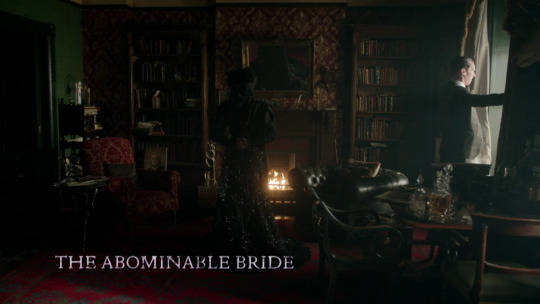
It’s hard to imagine what purpose TAB serves if not to drive home that Sherlock doesn’t totally trust Mary and is still ruminating over her past, and that he sees a connection between Mary and Moriarty. The arc of TAB doesn’t seem to mesh with HLV, and won’t seem to mesh with S4 prior to TFP, because the poor bastard is just stuck in his head running simulations. We’ll see why this one doesn’t stick when we get to the end of TAB.
From the start, Sherlock’s brain tells him that he’s going to have to go deep into himself.
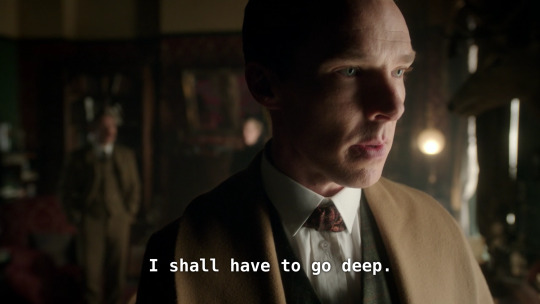
This is a clue that his mind has levels, some deeper than others. We’ll see that as TAB progresses. This is also a concept from the movie Inception that I mentioned earlier.
Also note Sherlock’s use of this phrase:
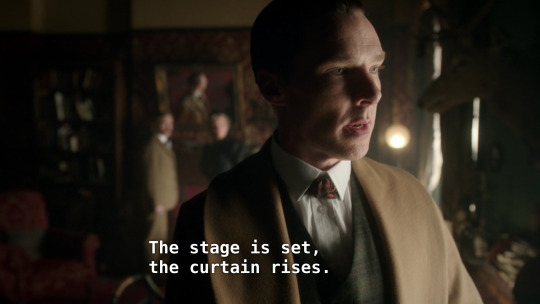
Sherlock will say this again in T6T, part of his mind echoing the conflict of TAB: what is going on with Mary? He also said this in TGG when Moriarty started his game with him, which links Mary and Moriarty in Sherlock’s mind.
Sherlock says they’re ready to begin and has Lestrade come on stage to set things up. Sherlock imagines a case about a terrible bride shooting people, obviously evocative of Mary. He has her wear lipstick like Irene Adler and sing “Do not forget me.” What did the opening recap remind us?

He even keeps a picture of Irene, and imagines a whole cult of underestimated women who tricked everyone. Sherlock’s mind knows he’s being tricked by a woman and should not forget it, but he can’t quite settle on Mary despite all the evidence. Why?
Well, Sherlock knows it would be all too easy for him to want John’s wife to be awful and out of the picture. Sherlock establishes that John isn’t enthusiastic about Mary, then later imagines John grilling him on his sexuality in the greenhouse. Sherlock agitatedly insists that sentiment would cloud his mind, and soon after imagines Moriarty taunting him about how he doesn’t actually care what’s going on and is just obsessing over John and sex. The idea horrifies Sherlock: he doesn’t want to think the worst of Mary just because of his feelings for John. Even if it seems realistic that John could be into him, he has to be objective.
So his brain tries to tell him that Mary must be working for Mycroft, not Moriarty. That... sort of makes sense, right? Mary was going after CAM partly for Mycroft and Lady Smallwood because she works for them. She’s not evil, she just needed a bit of excitement in her life because John ignores her. Plus she’s pregnant with John’s child, so Sherlock has to help her no matter how much it hurts him emotionally.

It may be worth noting, however, that Mary is not pregnant in Sherlock’s Victorian mind palace. Maybe buried deep, in the episode where Sherlock seems to almost have Mary’s number, Sherlock knows the baby isn’t real and he and John can just elope.
Sherlock’s subconscious mind also knows that Moriarty must be behind all this. His mind reminds him that Moriaty’s body was never recovered. He imagines a scenario similar to what I describe in M-theory where the sound of the gun going off comes from another gun wielded by an accomplice, and blood is splashed to fake the suicide. He goes nuts trying to dig up an ancient corpse just to see if the real body is there, but can’t get any answers because it’s all in his mind and he simply doesn’t know -- the same reason he can’t get solid answers about Mary’s past, only a trickle of snippets that don’t quite make sense. He imagines Moriarty is the head of the cult of underestimated women, wearing the bride’s dress and all.
It all just freaks Sherlock out too much to accept that Mary could be working for Moriarty, that Moriarty could still be alive. Minutes ago Sherlock had said he could never resist a touch of the dramatic (credit again to @1895 for the gif), which links this fake scene to the scene I mentioned outside Leinster Gardens in HLV:
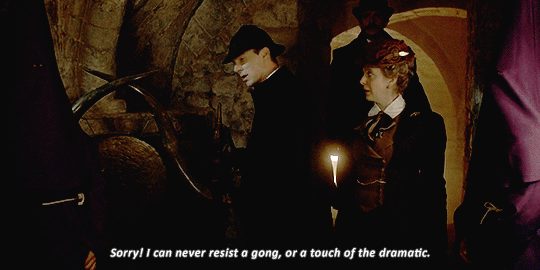
And then his mind has Moriarty mock him for being dramatic and making unrealistic shit up. The problem, Sherlock decides, is that Moriarty is a virus in his brain. Moriarty can’t be alive, Sherlock is just a scared drama queen and it’s ruining his ability to think clearly.
And John is clearly going to be Sherlock’s in the end! Sherlock has realized over the course of the episode that John is just following his lead because he’s concerned about what Mary will do. Moriarty is totally dead, and whatever is going on, he and John together will be victorious.
John kicks Moriarty off the waterfall, except... wait... Moriarty seems happy about it? Like that’s exactly what he wants to happen? (credit to @skulls-and-tea)
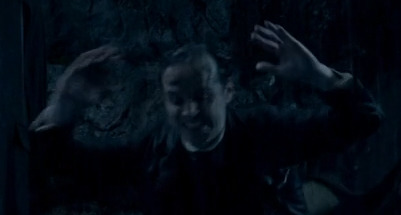
Sherlock throws off his detective hat, rejects fear, and embraces love by... jumping deeper, into water.
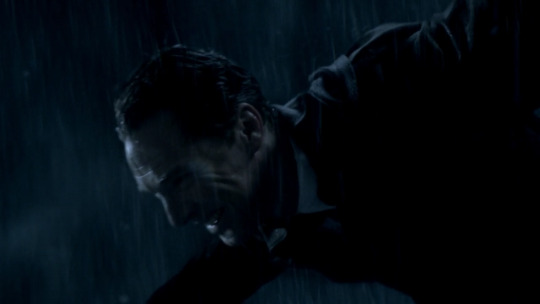
(Credit to @skulls-and-tea for this too because apparently Skully screamed at me about it six months ago and I forgot because I wasn’t seriously considering anything weird was going on, then I thought I noticed it myself when I went to write this LOL.)
Remember, curly dad keeps saying that Sherlock makes mistakes when he lets in sentiment. And this is a big, big mistake; Sherlock should have stayed paranoid. Moriarty did just say Sherlock would be the first man to ever be buried in his mind palace. And Sherlock just went even deeper than he was in this scene.
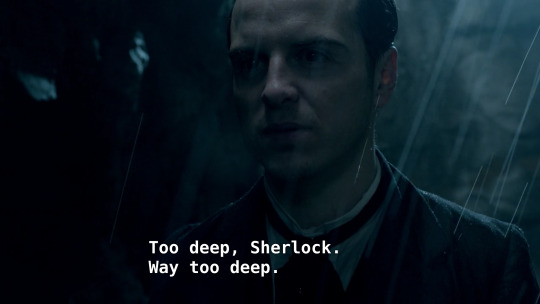
Son of a bitch! That’s not how you get out of your mind palace, Sherlock!
And how do we know he’s still stuck there? We see Sherlock talking to John and Mary about how Moriarty is totally dead and he totally knows what he’s going to do next, then they drive off the tarmac...
Except... then we get the epilogue. It has to happen somewhere, at some time in Sherlock’s brain. And it apparently happened after the tarmac scene we just saw, where Sherlock’s supposed to have sobered up?
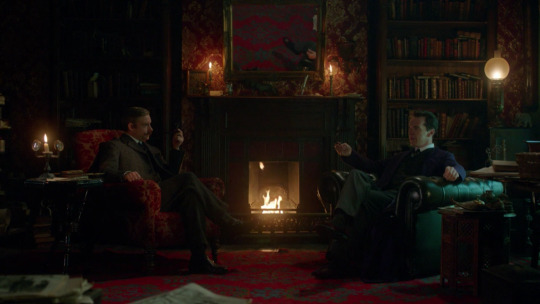
Sherlock’s still in his brain.
Aaaand shit, apparently you can hit size limits for posts because partway through adding the T6T images it greyed out the option to post or even save this as a draft. Please hang tight and I’ll get more posted hopefully today, HOPEFULLY before TFP airs tomorrow at the latest.
Tagging those who asked to be tagged: @tea-and-gingernuts @theheartandthebrain @softmolly @sherlockprettydamngayholmes @shrlk @alex4555
1K notes
·
View notes
Text
Project Evaluation (approx. 1000 words)
An important part of the way you develop your own photographic practice throughout the course is the relationship between your research (in all its forms) and your own creative practice. You should have been making regular updates on your blog throughout the semester and using it as a space to think through and develop your ideas. Project evaluation is an opportunity for you to reflect on, and summarize, these updates so that your tutors can have a clear overview of your working process, progress and development during the module.
Use the headings below as a guide and feel free to add to this and include images if you wish.
Project Title: Off The Wall
How did this develop and what was involved in the decision making process?
My original intentions for this project was to create album covers inspired by my own poetry, music taste, and views of the world. This process would have been inspired by music, poetry, art, photography and film. I wanted to do this project because i didn’t want to confine myself to a particular creative process; I wanted to be free and experiment with painting, drawing and text. I thought i could bring a fine art approach to this project and condense down into a graphic design. This way, I can be critical in my work and know how to distribute my images to a particular demographic. The decision making process was very important to me and I always took time to see what worked well and what didn’t. I decided not to include Tom’s photo-shoot in the final piece because the creative just wasn’t working and I believe the photos are not as strong as the others in my selection. There are also some images i didn’t include in the pieces because I thought they would not flow effectively. I changed the album art for Emily’s piece a couple of times. I thought the original did not look like an album cover. I added a water background and placed her image on top. I thought the relationship between the two layers did not work. I felt it needed more texture in order to bond a connection between the two. I thought the images were quite intimate themselves; so it did not need to be overwhelmed by another image. A simple border and text does it well.
Subject
Reflect on the subject matter of your project.
The subject matter for this project was not very personal or making a large statement- which is what I am used to. The purpose of this project was to see how creative I could be in image making when it comes to graphic design. The process was about seeing the potential of images and that photography can be a collaboration- with text, music and technology. I wanted the final piece to be tangible to it’s audience. I’ve called it ‘Off The Wall’ because the pieces themselves can be taken off the shelf and be experienced intimately. It is the best of both worlds. I want my audience to know that physicality and the way we experience art forms is incredibly important. The way we see things on the wall, in our hands, the way we hear things in our earphones or out loud is unimaginably influential.
Visual Research
Reflect on how key photographers / visual artists who are relevant to your project research have impacted upon the development of your project?
Explain how they influenced your approach and what you learned from them.
I first started my research at Tate Modern visiting the Robert Rauschenberg exhibition, which kick-started by project. I really liked one of his processes where he used lighter fluid on a piece of paper and sticking it to a magazine; he would then use an empty pen and draw on the other side. Through this process the image would come out on the paper. I was fascinated with this process and realised that I can create a lot of work through physical manipulation whether, that’d be painting, drawing or collage making. The exhibition was very inspiring.
I then started looking at my favourite album covers, and why I like them so much. I started to study their composition, use of colour and text. From here, I took some images and started to experiment with composition and digital collage. I then looked at photographers Nick Knight and Paola Kudack for my first photo-shoot. I was interested in the concept of body language and posing. I did a self portrait shoot, which prepared me for photographing other people and how they pose for the camera.
I also visited the Wolfgang Tillmans exhibition at the Tate, which was also very influential. My favorite parts of the exhibition were the corners of the wall where Tillmans put up several images next to each other. I loved the way he presented his work- It felt very personal and I was able to engage with the images on a new level. It all felt very tactile and it felt like it was presented like how someone would decorate their bedroom. There were also many books on display and was fascinated with the amount of archives he has. Tt had got me thinking in terms of how i want to display my work. This was when I knew I wanted the same tactile feel to my work; That people could pick up the photos and have a much more personal engagement with them. It was at this point where I thought I could call the piece ‘Off The Wall’. I knew that the exhibition space doesn’t need to be ‘professional’ or ‘glamorous’, it can be whatever I want it to be.
I also looked at photography books such as Sentimental Journey 2: Nobuyoshi Araki, Requests And Antisongs: James Richards, and Harry Callahan: The Street. I was fascinated with the creative processes of these works, and the way they were laid out on a page. I wasn’t sure if I wanted to make a book, but looking through the pages, I got an idea of how I could present images on a page, and the challenge of how can I make a page interesting. The Edgar Martin’s talk was very important to me. I was in love with his most recent project- Siloquies and Soliloquies on Death, Life and Other Interludes, 2016. The relationship between the personal imagery was incredibly emotional and is now the best piece of photography work I have ever seen.
Aims, Objectives, Concept
Discuss your aims and objectives and the main concept for your project and evaluate how successfully these have been resolved.
My main objective with this project was to be free in my creative processes and tackle my issue with photographing people. I think I was quite free in my decision making process when it came to creativity, however I think I could have explored much more process such as painting and scanning. I was afraid of the process not turning out well because the possibilities with this project are endless and sometimes the process don’t work well and this is an issue I have had in the past. I think I have photographed the models well. I definitely have some good photographs, however I wish I knew what more I could have done to tell the person who I was shooting. There is only so much I can do as the photographer- people either understand posing or they don’t.
Production
Reflect on the specific production methods you have been exploring and how these approaches and visual strategies have affected your project development.
Photoshop has been the main production method for me. I would print out photos on paper to see how the look on a page. From this, I would determine which photos are strongest, and which sequence it should go in. I would then retouch the photos and play around with composition and text until I came to a conclusion which I was happy with.
Presentation
How effectively have you communicated your ideas in relation to your identified audience and context?
I think I have communicated them well. I think the title works well with the concept and the work. I wanted to find a middle-ground with the way that the images are presented. In the exhibition I may have a CD player or a computer to play music on, while the person engages with my images.
Evaluation
Identify the strengths and weaknesses of your project and what you might do to improve it in the future?
Strengths:
I think I have a good concept with this project and have used technical skill well in my photography. I have communicated with people I do not know, which is a challange for me because I am quite a shy person. This has made me come out of my comfort zone and improve my confidence.
Weaknesses:
I have not experimented with material to its full potential. I don’t have a huge range of processes that I originally intended to do. Many of the photos were shot in a studio and share a very visible similarity. I could have changed it up and worked more in colour and escape the studio.
Improvement: To improve the project I would have fitted in more artists to collaborate with. I needed to have a legitimate conversation with them to talk about their music and what it means to them. This way, the creative process would be much clearer and I would have more of an idea of what to do with the images. Overall I am happy with this project and I am still continuing the photograph artists from this University. I hope to create much more stronger imagery and extended my creative possibilities.
1 note
·
View note
Text
The Real Champions: Some Final Thoughts and Analysis
Hey everybody, I want to thank those of you who took the time to read my series “The Real Champions” which set out to decide which teams actually deserved to claim national championships every year from 1900 to 2015. This was definitely one of my longest projects, certainly in the top two with the Realignment Rivalry Graveyard Countdown. Now that it’s over there’s a lot of information to parse through so I’m going to try to make a (relatively) condensed analysis of everything and find a few takeaways here and there.
This is the final part of a long series I’ve been writing, I would strongly suggest getting familiar with at least the rules that I’ve used to govern this project before beginning, and if you wanna start reading my decade by decade analysis you can start in the 2010′s or the 1900′s.
Before we start I want to announce two changes have been made to the list of champions. The first is because I started this project before the 2016 season began so it didn’t initially take into account Clemson’s championship. Second: I want to amend the 1978 season. At first I had only awarded Oklahoma a championship over Alabama and USC, but now I want to move the Trojans into a co-championship situation with the Sooners. I still won’t award the Tide a title since they got smoked by SC early in the season.
Now, on to the analysis!
-
The Raw Data
Here is the full list of every team I awarded a championship and for which seasons:
Alabama: 14 (1925, 1926, 1930, 1934, 1961, 1965, 1966, 1975, 1979, 1992, 2009, 2011, 2012, 2015)
Arkansas: 1 (1964)
Army: 5 (1914, 1916, 1944, 1945, 1946)
Auburn: 3 (1957, 1983, 2010)
California: 4 (1920, 1921, 1922, 1937)
Chicago: 2 (1905, 1913)
Clemson: 2 (1981, 2016)
Colgate: 1 (1932)
Cornell: 4 (1915, 1921, 1922, 1939)
Florida: 3 (1995, 2006, 2008)
Florida State: 3 (1993, 1999, 2013)
Georgia: 2 (1942, 1980)
Georgia Tech: 4 (1917, 1928, 1952, 1990)
Harvard: 4 (1901, 1908, 1912, 1913)
Illinois: 3 (1914, 1923, 1927)
LSU: 3 (1958, 2003, 2007)
Maryland: 1 (1951)
Miami: 5 (1983, 1987, 1989, 1991, 2001)
Michigan: 10 (1901, 1902, 1903, 1904, 1923, 1932, 1933, 1947, 1948, 1997)
Michigan State: 3 (1951, 1952, 1966)
Minnesota: 7 (1903, 1904, 1934, 1935, 1936, 1940, 1941)
Nebraska: 5 (1970, 1971, 1994, 1995, 1997)
Notre Dame: 13 (1924, 1929, 1930, 1943, 1946, 1947, 1949, 1953, 1966, 1973, 1977, 1988, 1993)
Ohio State: 5 (1942, 1954, 1968, 2002, 2014)
Oklahoma: 10 (1949, 1954, 1955, 1956, 1967, 1974, 1975, 1978, 1985, 2000)
Ole Miss: 3 (1959, 1960, 1962)
Penn State: 5 (1911, 1969, 1982, 1986, 1994)
Pennsylvania: 2 (1904, 1908)
Pittsburgh: 6 (1910, 1915, 1916, 1917, 1937, 1976)
Princeton: 3 (1906, 1922, 1933)
SMU: 1 (1982)
Stanford: 2 (1926, 1940)
Syracuse: 1 (1959)
Tennessee: 3 (1938, 1950, 1998)
TCU: 1 (1938)
Texas: 3 (1963, 1969, 2005)
Texas A&M: 3 (1919, 1927, 1939)
UCLA: 1 (1954)
USC: 8 (1931, 1932, 1962, 1967, 1972, 1978, 2003, 2004)
Washington: 2 (1984, 1991)
Washington & Jefferson: 1 (1921)
Yale: 5 (1900, 1905, 1906, 1907, 1909)
There we have it. Every national championship from 1900 to 2016 based on the criteria I used to judge who was most worthy. Now clearly these titles don’t feel equally relevant anymore. Scrolling down to see Chicago’s two national championships and then Clemson’s doesn’t mean both teams have equal standing in the modern game. I’ll break down each of the champions by categories that roughly put them among peers.
-
The Breakdown of the Champions
The All-Time Best Programs in College Football
There are modern day powers, the blue bloods of the sport, and then there are absolute best. These few programs have set themselves apart more than any other in the sport and are probably what immediately comes to mind when you think of college football’s very best teams.
Alabama Crimson Tide: 14 national championships (1925, 1926, 1930, 1934, 1961, 1965, 1966, 1975, 1979, 1992, 2009, 2011, 2012, 2015)
Alabama has been the most successful winner in the entire sport since the South became relevant in the game starting in the 1920′s. The Crimson Tide rode an initial wave of success under Wallace Wade and Frank Thomas in the 1920′s and 1930′s to mark themselves as the best team in the South. Bear Bryant’s record setting pace in the 1960′s and 70′s put them among the best of the best. Just for added measure, Nick Saban’s current dynasty has pushed Bama past Notre Dame as the top program based on championship numbers.
Notre Dame Fighting Irish: 13 (1924, 1929, 1930, 1943, 1946, 1947, 1949, 1953, 1966, 1973, 1977, 1988, 1993)
Perhaps the most classic name associated with college football. Notre Dame was the most successful program in the 20th Century. The Fighting Irish burst on to the scene with Knute Rockne in the 1920′s. Frank Leahy guided the Irish to their greatest success in the 1940′s. Ara Parseghian, Dan Devine, and Lou Holtz join the ranks as the head men who made sure that ND won national championships in every decade from the 1920′s to the 1990′s, easily the longest run any team has had.
Oklahoma Sooners: 10 (1949, 1954, 1955, 1956, 1967, 1974, 1975, 1978, 1985, 2000)
Oklahoma dominated the last half of the 20th Century more than any other school. The Sooners spotted their fellow all-timers about 20 years then raced out to a similar pace. Bud Wilkinson’s big run through the 50′s and Barry Switzer’s tenure in the 70′s and 80′s provided OU with most of their championships.
USC Trojans: 8 (1931, 1932, 1962, 1967, 1972, 1978, 2003, 2004)
I have trouble placing USC. They are a cut above the other blue blood programs in terms of championships, but they have nearly half as many titles as Alabama, the highest of the all-timers, so they feel somewhat out of place there as well. You could put them in either category, but I’m choosing to put them with the all-timers based on their three periods of huge success that matches up with the other schools on here. Howard Jones in the 30′s, John McKay and John Robinson in the 60′s and 70′s, as well as Pete Carroll in the 2000′s ran out of the tunnel with some of the best teams football has ever witnessed.
Michigan
I have to create a special category for Michigan. They do and do not fall into several of the categories I already made and stand apart somewhat.
Michigan Wolverines: 10 (1901, 1902, 1903, 1904, 1923, 1932, 1933, 1947, 1948, 1997)
By number of championships, Michigan belongs in the All-Time Best conversation, however they’ve only won a single title since 1950 which absolutely DOES NOT put them in similar company as Alabama, Notre Dame, Oklahoma, and USC, who’ve won 31 in the same time frame. Their championship profile resembles a Pittsburgh, Minnesota, or other diminished former powers that have waned in importance. But unlike the Panthers or Gophers, the Wolverines are the definition of a blue blood program. UM is #1 in all-time wins and in win percentage and they’ve had success throughout the entire modern history of the sport. Michigan has the wins and the dominance of an Alabama or Notre Dame, they just could never win the right games to get them a championship ever since they truly fell off the pace in the 1940′s. The Wolverines exist separately from these of the other programs so I’ll give them this special area.
True Blue Bloods
The Blue Bloods are the teams with success both past and present. They’re what we consider traditional powers in the sport of college football. Make no mistake, even though I set a few above them, these are the tier 1 schools just the same.
Ohio State Buckeyes: 5 (1942, 1954, 1968, 2002, 2014)
The definition of a blue blood program, Ohio State has been a consistent winner for decades. The Buckeyes are the most successful modern Big Ten team since Michigan and Minnesota stopped regularly winning championships in the 1940′s.
Nebraska Cornhuskers: 5 (1970, 1971, 1994, 1995, 1997)
Depending on which dates you actually use, Nebraska is the winningest program of the last 60 or so years. The Cornhuskers had stretches of success before the 1960′s, but the arrival of Bob Devaney put them on top. The program prospered further under Devaney’s successor Tom Osborne. From the 60′s until about 2000, Nebraska was easily one of the best teams in the country. They did well for themselves in winning five championships, but they had close calls seemingly every year, and it feels like they could have won 15 if the breaks had gone their way.
Penn State: 5 (1911, 1969, 1982, 1986, 1994)
The Nittany Lions were also one of the most successful programs in the last 50 years under Joe Paterno. Penn State was a big winner in my own system, but in reality they only claim two championships in their long history though they deserved at least four. I’m sure some of you will think that there’s some kind of retroactive karmic justice to that. I won’t dispute it.
Texas Longhorns: 3 (1963, 1969, 2005)
They don’t have as many championships as a USC or an Ohio State, but boy don’t they act like it? I don’t want to take away anything from Texas’ great stints in the 40′s, the 60′s and 70′s, and the 2000′s under Dana Bible, Darrell Royal, and Mack Brown respectively. Those Longhorns teams were world beaters. Overall, UT was a dominant force that has more or less Michigan-ed things because they’ve been about as good as the rest of these teams in the Blue Bloods category, they just won a few fewer championships.
Tennessee Volunteers: 3 (1938, 1950, 1998)
Alright, Tennessee sorta doesn’t fit here. They have a low number of championships and don’t have the super high win percentage and dominance that Texas can fall back on. Yet, the Volunteers stand out from those in the next tier by virtue of long periods of success, particularly under Robert Neyland, Johnny Majors, and Phillip Fulmer. Also, I think I took at least two championships from them that they would otherwise claim to bolster their case. They can be a blue blood, but they’re on the fringe compared to the others.
Modern Powerhouses
These teams may have a checkered past, but their recent success has been undeniable. Modern powerhouses act like blue blood programs, though usually they only starting winning national championships in the past 20 or 30 years, separating them from the much longer history of the traditional powers. You’ll notice a certain pattern with these schools if you look close enough.
Miami Hurricanes: 5 (1983, 1987, 1989, 1991, 2001)
Before 1983, Miami was a small time program that had never distinguished itself in college football. Howard Schnellenberger, Jimmy Johnson, and Dennis Erickson built the Hurricanes into the most successful modern college football program this side of Tuscaloosa. The U as it came to be known dominated the game in the 80′s and the early 90′s. A shorter period of success in the late 90′s and early 2000′s added the most recent championship to Miami’s display cases. Unfortunately, the Canes haven’t seen their dominance sustain itself in the past decade, but their incredible run has made them a virtual overnight success in the longer gaze of football history.
Florida State: 3 (1993, 1999, 2013)
Bobby Bowden built Florida State into one of the most consistently dominating teams in the last quarter of the 20th Century. FSU was in the championship hunt every year for nearly 15 years. That they only won two championships in his tenure is somewhat remarkable in and of itself, they certainly left many on the table. The Seminoles have seen their success return under Jimbo Fisher, and are a great example of the modern football powerhouse.
Florida Gators: 3 (1995, 2006, 2008)
The Sunshine State has led the charge in college football since the 1980′s. Steve Spurrier built up the Florida Gators to a similar success that their rivals FSU and Miami saw in the 90′s. In his short tenure, Urban Meyer won two titles in three seasons to elevate Florida to the level of their in-state peers.
Regional Powers
Regional Powers are interesting programs. They are always relevant in their conference and when they’re playing at their peak they act like blue blood programs. They just haven’t seen as much success as their well-heeled brethren, though they can find their place in the sun if they work for it.
Auburn Tigers: 3 (1957, 1983, 2010)
They certainly have played second fiddle to arch-rival Alabama for most of their history, but Auburn is usually a good program and occasionally a great one. When the right man uses the right system, the Tigers can strike out and out-compete anybody, including the hated Crimson Tide.
LSU Tigers: 3 (1958, 2003, 2007)
LSU’s history has featured more ups and downs than many power programs. The Tigers had a period of success in the 1950′s and 60′s, but were unremarkable for a long time until Nick Saban revived the program and Les Miles carried the water for a good decade. Currently LSU is regarded as one of the best teams in the best conference and it’s hoped that they can keep things that way.
Michigan State Spartans: 3 (1951, 1952, 1966)
For a good two decades, Michigan State was a powerhouse in the Big Ten. The Spartans thrived under Biggie Munn and his successor Duffy Daugherty. They occasionally rise out of mediocrity to become a national contender for some years. Very recently under Mark Dantonio, MSU threatened to break through and start claiming national championships once again.
Texas A&M Aggies: 3 (1919, 1927, 1939)
Texas A&M has had an interesting history. The Aggies are consistently good, and as a result have very high standards for a team that hasn’t won a national championship since the 1930′s. They are a solid performer that has success very frequently, but they have trouble getting over the hump and actually winning titles.
Clemson Tigers: 2 (1981, 2016)
The most recent champs have just doubled their overall title count. Clemson had long streaks of success under Frank Howard and Danny Ford, and Dabo Swinney has started the ball rolling once more. They were the traditional power in the ACC until Florida State joined the conference, but currently both programs are competing at a very high level and are leading the league.
Washington Huskies: 2 (1984, 1991)
Under Don James, the Washington Huskies finally broke through and won a poll national title in 1991. But to say that Washington only had a peak in the last 80′s and early 90′s ignores their status as the far and away most successful program in the Pacific Northwest.
Georgia Bulldogs: 2 (1942, 1980)
Georgia is usually one of the solid programs in the SEC, but they rarely have achieved the heights of a national championship contender. Still, they are a quality program and a huge presence in that region of the country.
Arkansas Razorbacks: 1 (1964)
There was the high water mark under Frank Broyles that won the Razorbacks their only national championship. While Arkansas is usually a strong team, they just usually aren’t the very best.
UCLA Bruins: 1 (1954)
The Auburn to USC’s Alabama, so to speak. UCLA is almost always a competitive program, but they’ve been unable to leverage success in a talent-laden region for any long period of time because their next-door neighbor does it so much better.
Fallen Powers
In a certain age, these programs were college football royalty, with as much clout and name recognition as a Michigan or a Notre Dame. Sustaining success is difficult, especially for schools that are somewhat more demographically challenged or restricted by other means. These are the teams that used to be among the very best, but they’ve been unable to keep it up.
Minnesota Golden Gophers: (1903, 1904, 1934, 1935, 1936, 1940, 1941)
One of the most successful college football programs in the first half of the 20th Century. Minnesota had multiple football dynasties and a tradition of victory, but recruiting out to Minneapolis has always proved a challenge. The Golden Gophers haven’t seen any kind of real relevance since the 1960′s and it seems very unlikely that they’ll be able to reclaim their former glory.
Pittsburgh Panthers: 6 (1910, 1915, 1916, 1917, 1937, 1976)
Pitt was a dominant force in college football in the era of Pop Warner and Jock Sutherland from the 1910′s to the 1930′s. They slid into irrelevance until Johnny Majors revived the tradition of winning in the 1970′s. There was a time when Western Pennsylvania was considered the #1 recruiting hotbed in the country, but that hasn’t been the case in a while. The Panthers haven’t seen any kind of national prominence since the 80′s.
Army Black Knights: 5 (1914, 1916, 1944, 1945, 1946)
I guess if we have another kind of full-scale war that would allow Army to take the best players across the nation and put them on the team the Black Knights could conceivably win championships again. Outside of that horrible possibility it doesn’t seem likely that Army can regularly be a good team, let alone a great one, in this day and age. The demands of being a full time college athlete and a full time officer in the US military makes it nigh impossible for someone to do both. But let’s acknowledge Army’s stellar period of dominance in the 1910′s and especially in the 1940′s.
Georgia Tech Yellow Jackets: 4 (1917, 1928, 1952, 1990)
Georgia Tech was one of the very solid programs in college football for much of the early 1900′s. From John Heisman to William Alexander to Bobby Dodd the Yellow Jackets occasionally challenged for and won national championships. However, GA Tech hasn’t been nearly as successful since the 1960′s. Bobby Ross’ 1990 squad seemed to catch lightning in a bottle for one season, but for the most part it seems as though Georgia Tech has trouble maintaining a team that’s competitive at the highest level. Especially when they’re surrounded by so many other successful Southeastern schools with administrations that are more willing to take on players with more modest academic achievements.
California Golden Bears: 4 (1920, 1921, 1922, 1937)
Andy Smith’s 1920-23 dynasty was the first nationally competitive team to emerge from the West Coast. Building off that, the Cal Bears were one of the best teams in the PCC until the 1950′s. Ever since, and for not too obvious of reasons, Cal hasn’t been able to field nationally competitive teams outside of having Aaron Rodgers under center.
Illinois Fighting Illini: 3 (1914, 1923, 1927)
Illinois was a Big Ten power in its own right for a couple of decades around the 1920′s. The teams of Red Grange and Bob Zuppke regularly competed for and claimed championships. However, the Illini were just unable to keep pace with schools like Michigan and Ohio State. Like Minnesota, they were slowly edged out of national relevance as the Wolverines and Buckeyes came to increasingly dominate the league.
Been to the Mountaintop
These are programs that have won national championships but haven’t had too much time in the spotlight otherwise. Some of them have a long list of great moments, but something keeps them from breaking into the higher levels of the college football universe.
Ole Miss Rebels: 3 (1959, 1960, 1962)
Outside of an incredible run under Johnny Vaught, Ole Miss has been a rather unremarkable program for most of its existence.
Stanford Cardinal: 2 (1926, 1940)
Every once in a while, Stanford is good, and sometimes even great. But the Cardinal have had trouble being successful for long periods of time.
SMU Mustangs: 1 (1982)
SMU had some high points in the 1930′s and the 1980′s, but as a small private school in the middle of much larger company, it’s difficult for the Mustangs to build real success. The last time they were good was because they paid players to attend.
Syracuse Orange: 1 (1959)
Another demographically challenged school, Syracuse has had some good runs in the past, but they haven’t been great in a long while.
Maryland Terrapins: 1 (1951)
They’ve had more success than almost all of the old-school ACC programs, but that doesn’t say much. Maryland had a flash of brilliance under Jim Tatum in the 50′s, but otherwise they’ve had trouble not being mediocre.
TCU Horned Frogs: 1 (1938)
A more successful iteration of SMU, TCU had runs of success in the 30′s and they’re currently in the middle of one today.
Myths and Legends
The ancient ones, those who won in college football’s hazy early days but don’t play at the highest level any longer. All of them are smaller private schools that either don’t have the resources, can’t stand the sausage-making to be good at modern college football, or both.
Yale Bulldogs: (1900, 1905, 1906, 1907, 1909)
They started out the 1900′s very strong. In terms of total national championships, Yale is still one of the most decorated programs ever.
Cornell Big Red: 4 (1915, 1921, 1922, 1939)
The last of the nationally successful Ivy League schools. Cornell won championships into the 1930′s but they still had to bow out as the game changed around them.
Harvard Crimson: 4 (1901, 1908, 1912, 1913)
Another name that screams old-time college football. Harvard was a national power for decades until they slowly faded from relevance starting in the 1910′s.
Princeton Tigers: 3 (1906, 1922, 1933)
By some measures you could still claim that Princeton is the most successful college football program of all time, they’ve been awarded championships for 28 different seasons by various selectors. Though obviously nearly all of this success came in the very early days of the sport.
Chicago Maroons: 2 (1905, 1913)
One of the early powers outside of the Northeast, Amos Alonzo Stagg’s Chicago Maroons regularly competed with Michigan for supremacy of the Big Ten. Due to their small size, they struggled to compete with the much larger state institutions and eventually bowed out of the league. They are now a D-III program.
Penn Quakers: 2 (1904, 1908)
Slightly less successful than some of the other Ivy League programs, Penn still had their moments of glory.
Colgate Red Raiders: 1 (1932)
Colgate had an amazing season in 1932 but otherwise haven’t made much of a mark on major college football.
Washington & Jefferson Presidents: 1 (1921)
Probably the smallest and most unassuming schools to win a national championship. A great trivia answer.
-
Geographic Shifts
One of the things that comes pretty obvious if you’ve tracked this project is that the center of the college football universe has shifted throughout the sport’s history. Obviously the South is currently dominates college football, but it wasn’t always this way. The geographic center of the game has moved a couple of times since the 1869.
The Northeast was the original seat of college football power. Before 1901, no team outside of that region EVER claimed a national championship. The Northeast was still a very important arena in the sport for the first half of the 20th Century. From 1900 to 1919, schools in the Northeast claimed 22 national titles compared to 11 for the entire rest of the country, two thirds of the total championships won in that time span. It was mostly thanks to the Ivy League, Pittsburgh, and Army. From 1900 to 1946, the end of Army’s dynasty, the Northeast claimed 31 of the 76 total football titles I’ve assigned, a bit over 40% of the total. However, they haven’t been nearly as successful since. Only six or seven championships have been awarded to schools in the Northeast region since 1946 depending on if you count Maryland as a Northeast team, with four going to Penn State and one each to Pittsburgh and Syracuse. The relegation of the Ivy League along with the irrelevance of the service academies has made the Northeast a backwater in college football. Pittsburgh and Syracuse themselves haven’t done much on the national stage in nearly 30 years, so it feels even more unlikely that the region can win titles regularly ever again.
The Midwest, South, and West all claimed a piece of the pie from the Northeast, but the Midwest was arguably the most dominant region in the 20th Century. We’re gonna consider the Midwest to constitute the Big Ten, Big 8, and Notre Dame. Oklahoma is a bit of a strange case, they’re considered a Southern state but in college football they were always culturally Midwestern until they joined themselves to Texas when the Big 12 was formed. Once Michigan and Minnesota burst on the scene in the 1900′s it was on. From 1900 to 1909 those two schools claimed 8 out of 18 national titles awarded. In the 1940′s the success of Notre Dame, Minnesota, and Michigan meant that the Midwest claimed 10 of 15 total national championships, a full two-thirds of the total. Oklahoma led the charge in the 50′s, where the region won 7 national titles compared to 8 for the entire rest of the country. The last truly dominant period in the Midwest was in the 1970′s, when Oklahoma and Nebraska helped the region claim 7 titles when everyone else only took home 5. In the 1990′s, the Midwest still claimed 5 championships mostly due to Nebraska’s last dynasty, the rest of the nation took home 9 titles. Due to demographic shifts, the Midwest is struggling to keep pace with the South for supremacy in college football. Oklahoma won a title in 2000 and Ohio State won in 2002 and 2014, but otherwise there’s been an uncomfortable drought. Outside of the blue blood schools who can recruit based on reputation, it’s been difficult for the Midwest to claim some of the best talent the nation has to offer in this new millennium.
The South is completely in control of college football right now. It seems like basically every year a Southern team wins a national championship. From Texas to Florida the region contains nearly all of the top talent coming in from high school. The South had always been reasonably competitive starting in the 1920′s, but the region really started taking off with the emergence of the Florida schools in the 1980′s. In that decade, the South claimed 7 championship compared to 4 from the rest of the country, mostly thanks to Miami’s incredible run. In the 90′s, six different Southern schools won seven championships compared to seven from everywhere else. Since the turn of the century, the gap has become quite large. Depending on if you count Oklahoma as a Southern school or not, the South has claimed 13 or 14 of the 18 championships awarded since 2000. Alabama, Florida, and LSU have all claimed multiple championships in the past 17 years. It doesn’t look like this dominance will end anytime soon either. Unless something drastic changes in the culture of this sport, the South is going to dominate college football for the foreseeable future.
The West has never dominated college football like the other regions of the country, but they’ve always had some kind of success. There have always been strong teams to come from the region ever since Cal won their first title in 1920. Indeed, California as a state has won more titles than any other state in the nation, with 18 total championships compared to 17 for Alabama. Michigan, Pennsylvania, and Indiana (all by Notre Dame) tie for third with 13. The problem is that the region is simply still rather underpopulated outside of large urban centers. The rural populations that make up large swaths of college football fandoms elsewhere are just much smaller in most Western states. Since I stripped titles from BYU and Colorado, the only states in the whole Western US to be awarded ANY championships have been California and Washington. Considering the inherent demographic challenges of the region, they’ve done well for themselves, though it also means they’ll probably be unable to compete with the South in the near future.
-
So there you have it. Those are some of the patterns I’ve noticed after writing what has amounted to a novella on this subject. I want to once again thank anybody who actually has been generous enough with their time to read all of this. I of course want to give a shoutout to my footblr pals @collegefootball128, @thechlostertalkssports, and @saturdaystars. I think they’ll be happy with my assessment of their favorite teams. If anybody has any questions about the process or any feedback, please don’t hesitate to write in, I always try to respond to any fan mail about my projects.
I might take a short little break, this project has taken me a very long time to complete so I need to recharge a bit. But don’t worry, I’ll be back, I’ve already got a number of ideas for my next long-form project!
Thanks once again!
-thecfbg
#college football#Alabama Crimson Tide#Arkansas Razorbacks#Army Black Knights#Auburn Tigers#California Golden Bears#Chicago Maroons#Clemson Tigers#Colgate Red Raiders#Cornell Big Red#Florida Gators#Florida State Seminoles#Georgia Bulldogs#Georgia Tech Yellow Jackets#Harvard Crimson#Illinois Fighting Illini#LSU Tigers#Maryland Terrapins#Miami Hurricanes#Michigan Wolverines#Michigan State Spartans#Minnesota Golden Gophers#Nebraska Cornhuskers#Notre Dame Fighting Irish#Ohio State Buckeyes#Oklahoma Sooners#Ole Miss Rebels#Penn State Nittany Lions#Penn Quakers#Pittsburgh Panthers
4 notes
·
View notes
Text
143. Sherman Sam
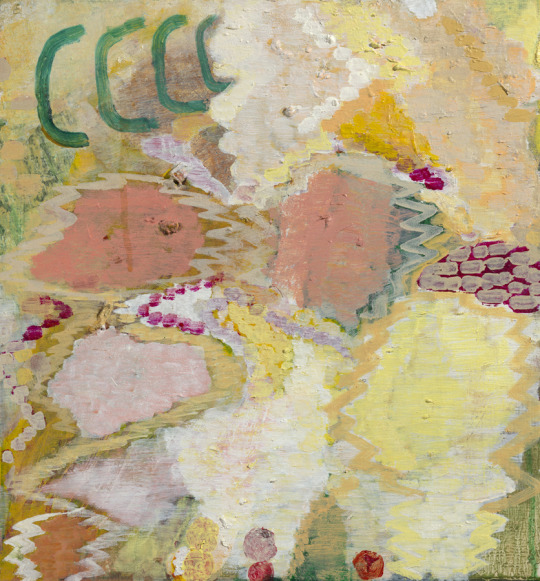
Sherman Sam, Do The Same Again, 2016. Oil paint on ply; 31.4 x 29.1 cm. Image courtesy the artist and Annka Kultys.
Following his first UK solo-show at Annka Kultys, London, Traction talked with abstractionist painter, Sherman Sam, about his process and approach to painting. Focusing on the transience and movement of colour, surface, light and intuition; whilst his painterly style can be aligned with the East-Coast Abstractionists, his work opposes typically Western notions of narrative structure altogether. With a career that has spanned the last three decades and across three continents, Sam is a vastly knowledgeable, engaged and enquiring mind in the field of Contemporary Art. A pre-eminent art writer, Sam contributes regularly to Artforum International.
Could you discuss how you approach each painting? Do you have any rituals or particular processes which determine how the work begins and then evolves?
I wish I could say that it’s like being a sportsman where you have your lucky boots, or cross yourself then kiss the field before you play… but it’s not quite like that. Not even lucky brushes or painting slippers… dammit!
At any one time there are some 15-20 works in progress. Some of these have just been sitting in the studio for some years. I would say that half of them are getting more attention than the rest. I move them round, glance at them. A touch of paint here and a touch there, that’s the main action, and not always every day. BUT it is the looking and trying to stumble on to a solution or way forward that takes the time. Well, sometimes it’s not a stumble, but the accidental path is always the most satisfying because it’s so much less predictable. So even those seemingly forlorn pieces sitting around collecting dust, are really still being thought over somewhere in the back of my mind.
How does a painting come together? First I cut and assemble the panels. So when I begin to paint, they already have some sort of determined rectilinear shape. Then I make some marks on the primed panel, maybe a splatter or two, or in earlier pieces a light wash. These actions determine some of the under structures of what becomes the painting. Likewise my drawings follow a similar process. They come about in a process of, lets call it, searching, working through, erasure and then finally equipoise. They too are cut from larger sheets of paper. Both drawings and paintings are the result of some kind of spontaneity and predetermination.

Sherman Sam, Installation view ‘Together We’re Heavy’, Annka Kultys Gallery, London, 17 November- 17 December 2016. Image courtesy the artist and Annka Kultys.
How has your formal language evolved with time?
Let’s call them the things I paint and draw.... “Formal language” begs for “conceptual ideas” and I don’t believe the two are separate. I think the two are so integral to each other in the best work that one cannot speak of one without the other. When I began to conceive this work in the mid-90s, I think the forms in the paintings were very organic and biological on the one hand, and architectonic on the other. You could say that American East Coast abstractionists emerging in the 80s like Tom Nozkowski, Jake Berthot, Gary Stephan, Jonathan Lasker, offered a point of departure. The forms then were usually painted on a rough field or background. The paint itself was quite thick. I think over the years, form and ground have become more intermixed while the paint has become thinner though still layered. The nature of the forms themselves, more and more, are now more constructed through gestures. So dabs of paint come together to define or outline form.
But it is not just the visual language that has evolved; there is also the thing language. The paintings (as opposed to pictures) began as more precisely made things, nicely into having a slightly more wonky (just a bit) handmade nature. Why? Paintings are things in the world, like, well, other things in the world. However they might just sit there and be a bit more thoughtful. Their imprecise nature is a reflection of their internal logic but also the rickety world around us.
Looking at the work in your show at Annka Kultys, I found myself finding references to pattern and western language. How do you feel when these figurative readings are transposed onto the work? How would you choose to describe these forms?
When asked I describe myself as an abstractionist. But if I were a pedant, I would say they really are non-representational. Basically there is no referent, no narrative; sometimes I don’t even think there is any theory. But I like that viewers see things, and find things in them. Isn’t that your job as a viewer? To see and think. Interpret. To make meaning. So I am pleased that you see what you see.
I do like patterns, you should have visited my knitwear collection instead, but in the art it is more about repetition rather than a contentious creation of design. If you see patterning, it is really more the movement of the hand or arm, again and again. Don’t they say that as human beings we look for patterns? As for language, do you mean western language? As opposed to Eastern language?

Sherman Sam, Just a Perfect Day, 2014. Oil paint on ply; 54.4 x 40.1 cm. Image courtesy the artist and Annka Kultys.
Yes, I found myself seeing references to the Latin or Germanic alphabet, which I know is based in my anglicised reading of certain forms.
I think in the drawings there are more graphic elements that could be construed as being derived from architectural diagrams and also graphics but less so in the paintings. But I think the element that most resembles what you are talking about can be found in do the same again, 2016, where there are four green curving marks suggesting “C C C C” the first being the largest and descending in size to the four, that is if you look from left to right. I think of it as marks emanating from right to left, like a force growing or in today’s terms, that little Wi-Fi strength signal on your phone or computer. And no, it is not derived from computer graphics, more like, in my mind at least, movement lines that you find in comic books. American comics when I was a kid inspired me to draw, you can blame them for my art. It is really mark making and repetition. Well, as I said what you see is what you see, or is that what you think you see is what you think?
You have lived in diverse geographical regions, hailing from Singapore you moved to Paris, the US and then London. What impact have these migrations had upon your practice?
Lots! Though I think unquantifiable. First you are exposed to different approaches to art making, not to mention different scenes, people, times, thinking and cultures. Now we have better, more instant information, so in a way we are better informed. Back then you just had to go somewhere; otherwise magazines and word of mouth were the only other sources. If you grow up in a small country like Singapore, where there was hardly any visual art when I was young, you really had to travel. Then there wasn’t even a museum dedicated to art. Today I still think you still have to physically see and experience art. Sure its images are transported and transposed, but the experience of a work is still key. On the other hand this does explain why so much art is made of images and about image.

Sherman Sam, Installation view ‘Together We’re Heavy’, Annka Kultys Gallery, London, 17 November- 17 December 2016. Image courtesy the artist and Annka Kultys.
As an artist I like to think I have a bit of Paris, Los Angeles and San Francisco in me, not to mention a whole lot that is Singaporean. However it is French and New York painting that are probably the most influential to the aesthetic journey I have taken. I would the scale is more European but the language and ideas begin on the East Coast. As for the Asian and Chinese bits, well I think its somewhere in there too, submerged but present.
Interview by Charlotte Barnard.
Sherman Sam’s exhibition, ‘Together We’re Heavy’, was on view at Annka Kultys Gallery, London 17 November – 17 December 2016. Read more here.
Sherman Sam is nominated for the 2017 Sovereign Asian Art Prize in Hong Kong – Asia’s most esteemed contemporary art prize.
He is soon to have a solo exhibition opening in Paris, to keep up with this, and other news regarding his work, please follow his artist page here.
#artist#sherman sam#painting#abstract#writer#annka kultys#london#Paris#east coast#image#Form#graphic#Architecture#diagrams#east coast abstractionists#process#exhibitions#artist interview#pattern#movement#language
3 notes
·
View notes
Text
Reagan: Pragmatist or Conservative Purist?
Getting Right with Reagan: The Struggle for True Conservatism, 1980-2016, by Marcus Witcher, University Press of Kansas, 448 pages, February 2020.
On January 19, 1989, as the fortieth president of the United States, Ronald Reagan, departed the White House, the New York Times reported that “no one credits Mr. Reagan with being much of an intellect,” the went on to question, “does anyone call him a hard worker or active leader.” Rather, the newspaper of record claimed, Reagan’s “strength lay in delivering lines that were arranged for him.” While such words might not be totally shocking, given the source, what Marcus Witcher reveals in his extraordinary and critical new book, Getting Right with Reagan: The Struggle for True Conservatism, 1980-2016, is that such views did not emerge merely from the left. Conservatives, too, dumped on Reagan, criticizing everything from his failure to free the market sufficiently enough to his placating of the Soviet Union. To be sure, no one, left or right, could have predicted the complete collapse of Eastern European communism over the next several months, and such knowledge might very well have reshaped even the New York Times’s opinion of the greatest president of the twentieth century.
Witcher: The Best of the Best of the Rising Generation
A recently-minted PhD in history, Marcus M. Witcher is, arguably, the finest and most impressive young scholar in a generation. As his first book it would make even the most senior scholar and historian proud. Even the opening line—“Ronald Reagan was no conservative ideologue”—is immediately captivating. From there, the book only improves. “This book recasts Reagan as a shrewd political operator who often moderated his conservative positions—much to the vexation of conservatives during the 1980s.” Rather than being ideological on fine points of intellectual rigor, “Reagan was a pragmatic conservative who understood that building coalitions across party lines was essential to effective governance.”
Getting Right with Reagan advances four arguments.
First, Witcher convincingly argues that conservatives thought little of Reagan during his two terms as president. They were, for better or worse, the first to criticize the man and find his shortcomings.
Second, the author notes, again well, that Reagan’s successful waging of the Cold War—though, mostly in hindsight—allowed conservatives to recreate their image of him as a sort of secular demigod, allowing his life and character to be the “glue” that holds together the movement after the fall of communism. Prior to Reagan’s success as a Cold Warrior, anti-communism had held together the various strands of conservatism.
Third, Witcher claims that post-Reagan conservatives and Republicans have moved “significantly to the right.” These post-Reagan conservatives seek to out-Reagan each other. In other words, Reagan has become a myth and a symbol far different than he was in reality.
Finally, Witcher makes a convincing case for ending his study in 2016. When I first saw the title—before having read the book—I scratched my head. Why not take the analysis up through 2019? As it turns out, Witcher reveals that Trump has never attached himself to the Reagan legacy or to the large currents of conservatism. Rather, he had done everything possible to present only himself, in full populist mode, separate from any recent president. “Trump did not invoke Reagan’s name or run on his platform during the primary or general election,” Witcher writes in the conclusion. “Trump showed little to no inclination to embrace Reagan’s legacy at all, and many of his policy positions” have been simply contrary to Reagan’s own. Crazily, both President Obama and former Secretary of State Clinton have more explicitly embraced Reagan than has Trump.
In all of this, as should be obvious from the header, Witcher has painstakingly researched not only his position but every possible variation of criticism of Ronald Reagan from all parts of the political spectrum and even some from the apolitical. Kudos, of course, to the University Press of Kansas for allowing Witcher to employ nearly 150 pages of the book to endnotes and bibliography. The endnotes are not only stunningly masterful in terms of scope and breadth, but they are also revealing in terms of textual details. If I have one complaint about the book’s layout, it is that I might have sprained my wrist turning from chapter to endnotes. Certainly, the book is well constructed. If it had not been, the spine would’ve easily become unhinged from such page turning. Here’s hoping the second edition of this excellent book will have footnotes rather than endnotes.
What about Conservative Intellectuals?
If Witcher is to be criticized—and one would only do so at the reviewer’s own peril, as Witcher has anticipated almost all possible arguments against his position—it would be for conflating conservative intellectuals and academics with conservative pundits and talking heads. Witcher references and quotes William F. Buckley and Patrick Buchanan, but he looks to Russell Kirk only once, and he completely ignores Robert Nisbet, Eric Voegelin, Harry Jaffa, and their students.
Thus, one can question what exactly conservatism means. In the book one realizes quickly that conservatism is never actually defined, as it is a moving target, given status relative to the meanings assigned to it over the past forty years.
If Witcher had taken the views of, for instance, those of Kirk, Nisbet, and Jaffa, he might be able to offer his readers an objective lodestar, something by which one could navigate the last four decades of conservatism.
In his own writings, Kirk never failed to praise Reagan for being one of the—if not the—greatest conservatives of the twentieth century. In Reagan’s first year in office, Kirk gushed:
For his power of will, Ronald Reagan is honored already. He has had the audacity to declare that this American Republic will endure and thrive. He has been sufficiently bold to set his face against the prophets of decay. With the old Romans, he knows that audacity is a bulwark, and that fortune both fears and fears the audacious. The American Republic commenced with audacity; if that audacity is exhausted, the Republic must end. Ronald Reagan, the audacious American stage-manager just now, is not disposed to let fall that iron curtain of national destiny. For him, the American drama is not yet played out.
Reagan awarded Kirk the “Presidential Medal of Freedom” in 1989, and the recipient never lost his admiration for the 40th president. In his final words written towards the president, he wrote, “In Reagan was no touch of pomposity. He did not take himself more gravely, nor the world more gravely, than he must. After suffering some defeat in the Congress, he did not repine, but laughed, perhaps. He jested with bullets in him.”
Of the prominent conservative intellectuals of the 1980s, only Robert Nisbet openly disliked Reagan. Nisbet saw Reagan as a progressive in foreign as well as domestic policy. Reagan had, to Nisbet’s dismay, only honed and perfected the old Puritan jeremiad, proclaiming anywhere and everywhere, that America could perfect herself and claim a unique and expectational position in world history. In the pages of this august journal, only eleven years ago, my esteemed and beloved colleague, Richard Gamble, made a similar claim: “But overall, Reagan preached yet another version of sinless, progressive America that had more in common with Tom Paine and Woodrow Wilson than with Edmund Burke.”
Even more diabolic, according to Nisbet, Reagan used national security, like Nixon before him, as a cover for a coup d’état. “Before it is over the Reagan administration may well be proved to have captured the prize for systematic lying to the public,” Nisbet argued. “The Iran-contra episode alone has made the administration a formidable contender for the century’s prize. But it is well to recall that an imposing background exists for the Reagan accomplishments in public deception, a background going all the way back to President Wilson.”
Though Eric Voegelin never commented on Reagan beyond mere statements of fact, one of his most important students, Richard Allen, served as Reagan’s first National Security Advisor. Allen remembers well his conversation about the Cold War with Reagan 1977. When Allen asked the older man who he would wage the war against the Soviets, he merely answered, “My theory of the Cold War is, we win and they lose. What do you think about that?” Reagan, Allen remembers, never wavered on this issue. “Reagan went right to the heart of the matter. Utilizing American values, strength, and creativity, he believed we could outdistance the Soviets and cause them to withdraw from the Cold War, or perhaps even to collapse. Herein lay the great difference, back in early 1977, between Reagan and every other politician: He literally believed we could win, and was prepared to carry this message to the nation as the intellectual foundation of a presidency.” Never did Reagan’s understanding of freedom being superior to Soviet tyranny shift. “These themes never varied in the essentials, primarily because he was the principal author of everything he said,” Allen records, “and he would never say anything with which he disagreed.”
In Sum
None of these criticisms are worthy of much contemplation. My own interests lie in what conservative intellectuals think rather than what conservative pundits do. But I’m not the author of this wonderful book, and I cannot blame Witcher for writing the book that I might (but did not) have written. On his own terms and on his own ground, he had nothing to prove. More accurately he has through Getting Right with Reagan, already proven himself to be one of the finest young historians in the United States at present. That Witcher has no full-time, tenured position is not only criminal, but it reveals just how corrupt and bizarre academia is. Any college worth its salt should scoop this fine young scholar up just as quickly as possible.
Bradley J. Birzer is author of J.R.R. Tolkien’s Sanctifying Myth: Understanding Middle-earth as well as The Inklings: Tolkien and the Men of the West (forthcoming, ISI Books).
The post Reagan: Pragmatist or Conservative Purist? appeared first on The American Conservative.
0 notes
Link
The good news for Democrats is that the chance that Bernie Sanders will be their nominee in the fall has receded. The bad news is that Joe Biden is no prize as a candidate, which adds urgency to the discussion about who can juice up his ticket as the vice-presidential choice. Party leaders are now hotly debating the topic.A popular line of thinking is that Biden’s ticket must offer a bold choice that also ensures the kind of strong minority turnout that eluded Hillary Clinton in 2016. Jim Clyburn, the House majority whip whose last-minute endorsement of Biden delivered a South Carolina primary landslide for him, has a clear idea.“I doubt very seriously you’ll see a Democratic slate this year without a woman on it,” Clyburn predicted to reporters. “I would love for it to be a person of color.”Clyburn was echoed by Valerie Jarrett, who was a senior adviser to President Obama for eight years. She told CBS News that the Democratic nominee should “break with conventional wisdom and announce a running mate that’s a woman of color.”Jarrett was then cut off, so she didn’t get the chance to say who she thought that running mate should be. But no one is closer to the Obamas. Few believe that Jarrett would have expressed the preference for a woman of color unless she thought that someone she’s been close to for nearly 30 years was in the mix: Michelle Obama.The two have known each other for 30 years. In 1991, Jarrett, then deputy chief of staff to Chicago mayor Richard Daley, interviewed the then 26-year-old Michelle Robinson for a job. The Harvard Law School graduate impressed Jarrett. “She exuded competence, as well as character and integrity,” Jarrett wrote in her autobiography. Jarrett hired her, was introduced to her fiancé, Barack Obama, and then took the couple under her wing by introducing them to powerful elites in Chicago. So began the rise of the Obamas to the White House. Why not time for a second act?It would certainly be popular with the Democratic base, and Biden would need the base to turn out in large numbers this November if he becomes the nominee. A poll last month by Stanford’s Hoover Institution in conjunction with the Bill Lane Center for the American West and YouGov asked 1,507 registered voters in California whom they wanted as a vice-presidential nominee.Voters clearly expressed a desire for a woman. Michelle Obama was the choice of 31 percent of respondents. California’s Senator Kamala Harris was second, at 19 percent; Minnesota’s Senator Amy Klobuchar was third, at 18 percent; former Georgia state legislator Stacy Abrams was fourth, at 13 percent; and California venture capitalist Tom Steyer had 10 percent support.Normally the suggestion that Michelle Obama should be the vice-presidential choice would be viewed as out of the question. Michelle Obama is famously assertive, even pushy, behind the scenes. That’s not a typical profile for a vice president. And because few people believe that an 82-year-old Joe Biden would run for a second presidential term, there would be a danger of her overshadowing him as a waiting heir apparent. And despite her popularity across wide swaths of the electorate, she has shown almost zero interest in working with Republicans or treating those she considers fools kindly.But Biden has professed comfort with and even support for the idea. In response to a question from an Iowa voter in February, he said he would pick the former first lady “in a heartbeat,” although he suggested that both Obamas had found life after the White House “somewhat liberating.” He had previously supported the idea in an interview with Stephen Colbert, last September, before clarifying, “I’m only joking, Michelle, I’m joking.”But was he? “The Obamas have enjoyed three years away from the glare of publicity,” a longtime Chicago ally told me. “But if Trump were to win a second term, he would complete his self-proclaimed task of dismantling everything Obama had done. If the way to guarantee that wouldn’t happen involved Michelle running, it’s not out of the question.”And if Biden were to prefer an African American on the ticket, the other choices all present problems. Biden has said anyone he ran with would have to oppose Medicare for All, which would rule out New Jersey’s Senator Cory Booker. The name of Stacey Abrams, an unsuccessful candidate for Georgia governor in 2018, is in the mix. But she has never had experience beyond a state legislature and also has a string of ethical controversies in her past that would be fully scrutinized in the spotlight of a national race.Senator Kamala Harris of California is a possibility. On the negative side of the ledger, she viciously attacked Biden in a debate last summer by unfairly implying that his past opposition to forced busing was racist. But Biden has rarely held a political grudge for too long. Private polls, however, show that when some black voters learn that Harris is of mixed African-American and Indian-American heritage, their enthusiasm for her wanes.A major obstacle to a Biden-Obama ticket is, of course, that Michelle Obama has expressed no interest in the idea. When she appeared on Jimmy Kimmel Live in 2018, she said she wasn’t a candidate for office: “I’ve never had any serious conversations with anyone about it because it’s not something I’m interested in or would ever do. Ever.”Her husband agrees. “Let me tell you, there are three things that are certain in life: death, taxes, and Michelle is not running for president -- that I can tell you.”That statement makes sense to many Obama allies. They point out Michelle Obama’s longstanding disdain for the grubbiness of politics and its fundraising, the desire to protect her two daughters, and her unwillingness even to pretend to be friendly with people with whom she has disagreements. “When I had my photo taken with the Obamas after I became the first black chair of the Republican National Committee, she was pure ice,” recalls Michael Steele, now an MSNBC contributor. “There was no smile, only a glare. And I never got the photo.”But there are countervailing arguments. As a vice-presidential nominee, she’d have to campaign for only 15 weeks -- versus the two years that a presidential run takes. And she could probably avoid fundraising, if she insisted on it. Her two daughters are now both in college, and the mainstream media would largely continue to respect limits on coverage of them. And as for her alleged dislike of meeting swarms of people? “She could literally just show up at events, wave, not say much, and the crowds would love her,” a Democratic pollster told me.Even with all that, the answer might be no. But there might be a sweetener that would prompt Michelle Obama to say yes. At an Iowa campaign stop in February, Biden was asked if he would nominate Barack Obama to the Supreme Court. After all, one previous president, William Howard Taft, made the journey from the Oval Office to the highest court, in the 1920s. Biden responded: “Yeah, I would, but I don’t think he’d do it. He’d be a great Supreme Court justice.”But I wonder if Biden’s view is accurate. Obama, a former law-school professor, would enjoy the court’s intellectual atmosphere. And who would more appreciate being on the nation’s highest court? He would provide an alternative to Justice Clarence Thomas’s black-empowerment conservatism and could provide the swing vote needed to strike down much of the Trump administration’s legacy.Some Democrats are so taken with the idea of putting Michelle on the ticket that they have speculated that Biden could even choose Barack himself as his running mate. But a similar idea came up in 2016, when Hillary Clinton was asked if she would pick her husband as vice president. She admitted that the idea had "crossed her mind" but then shot it down as unconstitutional. "He would be good, but he's not eligible, under the Constitution,” she told Extra’s Mario Lopez. “He has served his two terms, and I think the argument would be that as vice president, it would not be possible for him to ever succeed to the position -- at least that's what I've been told.”Everyone with whom I discussed a potential Michelle Obama candidacy said it would provide short-term pluses for a Democratic ticket by energizing it as nothing else could. Much of the media would be ecstatic and provide their normal fawning coverage of an Obama. But her presence on the ticket would probably create problems as well as opportunities for the Democrats. Regardless, party members worried about Biden’s shaky campaigning skills and performance would cling to the choice of Michelle Obama like a life raft.Of course, most political observers with whom I spoke predicted that Biden would not pick Mrs. Obama. On the other hand, few believed that George W. Bush would pick Dick Cheney as vice president, or that John F. Kennedy would choose Lyndon Johnson as his running mate.Stranger things have happened in politics, and in the Age of Trump, they often do.
from Yahoo News - Latest News & Headlines https://ift.tt/38Fy8Zy
0 notes
Link
The good news for Democrats is that the chance that Bernie Sanders will be their nominee in the fall has receded. The bad news is that Joe Biden is no prize as a candidate, which adds urgency to the discussion about who can juice up his ticket as the vice-presidential choice. Party leaders are now hotly debating the topic.A popular line of thinking is that Biden’s ticket must offer a bold choice that also ensures the kind of strong minority turnout that eluded Hillary Clinton in 2016. Jim Clyburn, the House majority whip whose last-minute endorsement of Biden delivered a South Carolina primary landslide for him, has a clear idea.“I doubt very seriously you’ll see a Democratic slate this year without a woman on it,” Clyburn predicted to reporters. “I would love for it to be a person of color.”Clyburn was echoed by Valerie Jarrett, who was a senior adviser to President Obama for eight years. She told CBS News that the Democratic nominee should “break with conventional wisdom and announce a running mate that’s a woman of color.”Jarrett was then cut off, so she didn’t get the chance to say who she thought that running mate should be. But no one is closer to the Obamas. Few believe that Jarrett would have expressed the preference for a woman of color unless she thought that someone she’s been close to for nearly 30 years was in the mix: Michelle Obama.The two have known each other for 30 years. In 1991, Jarrett, then deputy chief of staff to Chicago mayor Richard Daley, interviewed the then 26-year-old Michelle Robinson for a job. The Harvard Law School graduate impressed Jarrett. “She exuded competence, as well as character and integrity,” Jarrett wrote in her autobiography. Jarrett hired her, was introduced to her fiancé, Barack Obama, and then took the couple under her wing by introducing them to powerful elites in Chicago. So began the rise of the Obamas to the White House. Why not time for a second act?It would certainly be popular with the Democratic base, and Biden would need the base to turn out in large numbers this November if he becomes the nominee. A poll last month by Stanford’s Hoover Institution in conjunction with the Bill Lane Center for the American West and YouGov asked 1,507 registered voters in California whom they wanted as a vice-presidential nominee.Voters clearly expressed a desire for a woman. Michelle Obama was the choice of 31 percent of respondents. California’s Senator Kamala Harris was second, at 19 percent; Minnesota’s Senator Amy Klobuchar was third, at 18 percent; former Georgia state legislator Stacy Abrams was fourth, at 13 percent; and California venture capitalist Tom Steyer had 10 percent support.Normally the suggestion that Michelle Obama should be the vice-presidential choice would be viewed as out of the question. Michelle Obama is famously assertive, even pushy, behind the scenes. That’s not a typical profile for a vice president. And because few people believe that an 82-year-old Joe Biden would run for a second presidential term, there would be a danger of her overshadowing him as a waiting heir apparent. And despite her popularity across wide swaths of the electorate, she has shown almost zero interest in working with Republicans or treating those she considers fools kindly.But Biden has professed comfort with and even support for the idea. In response to a question from an Iowa voter in February, he said he would pick the former first lady “in a heartbeat,” although he suggested that both Obamas had found life after the White House “somewhat liberating.” He had previously supported the idea in an interview with Stephen Colbert, last September, before clarifying, “I’m only joking, Michelle, I’m joking.”But was he? “The Obamas have enjoyed three years away from the glare of publicity,” a longtime Chicago ally told me. “But if Trump were to win a second term, he would complete his self-proclaimed task of dismantling everything Obama had done. If the way to guarantee that wouldn’t happen involved Michelle running, it’s not out of the question.”And if Biden were to prefer an African American on the ticket, the other choices all present problems. Biden has said anyone he ran with would have to oppose Medicare for All, which would rule out New Jersey’s Senator Cory Booker. The name of Stacey Abrams, an unsuccessful candidate for Georgia governor in 2018, is in the mix. But she has never had experience beyond a state legislature and also has a string of ethical controversies in her past that would be fully scrutinized in the spotlight of a national race.Senator Kamala Harris of California is a possibility. On the negative side of the ledger, she viciously attacked Biden in a debate last summer by unfairly implying that his past opposition to forced busing was racist. But Biden has rarely held a political grudge for too long. Private polls, however, show that when some black voters learn that Harris is of mixed African-American and Indian-American heritage, their enthusiasm for her wanes.A major obstacle to a Biden-Obama ticket is, of course, that Michelle Obama has expressed no interest in the idea. When she appeared on Jimmy Kimmel Live in 2018, she said she wasn’t a candidate for office: “I’ve never had any serious conversations with anyone about it because it’s not something I’m interested in or would ever do. Ever.”Her husband agrees. “Let me tell you, there are three things that are certain in life: death, taxes, and Michelle is not running for president -- that I can tell you.”That statement makes sense to many Obama allies. They point out Michelle Obama’s longstanding disdain for the grubbiness of politics and its fundraising, the desire to protect her two daughters, and her unwillingness even to pretend to be friendly with people with whom she has disagreements. “When I had my photo taken with the Obamas after I became the first black chair of the Republican National Committee, she was pure ice,” recalls Michael Steele, now an MSNBC contributor. “There was no smile, only a glare. And I never got the photo.”But there are countervailing arguments. As a vice-presidential nominee, she’d have to campaign for only 15 weeks -- versus the two years that a presidential run takes. And she could probably avoid fundraising, if she insisted on it. Her two daughters are now both in college, and the mainstream media would largely continue to respect limits on coverage of them. And as for her alleged dislike of meeting swarms of people? “She could literally just show up at events, wave, not say much, and the crowds would love her,” a Democratic pollster told me.Even with all that, the answer might be no. But there might be a sweetener that would prompt Michelle Obama to say yes. At an Iowa campaign stop in February, Biden was asked if he would nominate Barack Obama to the Supreme Court. After all, one previous president, William Howard Taft, made the journey from the Oval Office to the highest court, in the 1920s. Biden responded: “Yeah, I would, but I don’t think he’d do it. He’d be a great Supreme Court justice.”But I wonder if Biden’s view is accurate. Obama, a former law-school professor, would enjoy the court’s intellectual atmosphere. And who would more appreciate being on the nation’s highest court? He would provide an alternative to Justice Clarence Thomas’s black-empowerment conservatism and could provide the swing vote needed to strike down much of the Trump administration’s legacy.Some Democrats are so taken with the idea of putting Michelle on the ticket that they have speculated that Biden could even choose Barack himself as his running mate. But a similar idea came up in 2016, when Hillary Clinton was asked if she would pick her husband as vice president. She admitted that the idea had "crossed her mind" but then shot it down as unconstitutional. "He would be good, but he's not eligible, under the Constitution,” she told Extra’s Mario Lopez. “He has served his two terms, and I think the argument would be that as vice president, it would not be possible for him to ever succeed to the position -- at least that's what I've been told.”Everyone with whom I discussed a potential Michelle Obama candidacy said it would provide short-term pluses for a Democratic ticket by energizing it as nothing else could. Much of the media would be ecstatic and provide their normal fawning coverage of an Obama. But her presence on the ticket would probably create problems as well as opportunities for the Democrats. Regardless, party members worried about Biden’s shaky campaigning skills and performance would cling to the choice of Michelle Obama like a life raft.Of course, most political observers with whom I spoke predicted that Biden would not pick Mrs. Obama. On the other hand, few believed that George W. Bush would pick Dick Cheney as vice president, or that John F. Kennedy would choose Lyndon Johnson as his running mate.Stranger things have happened in politics, and in the Age of Trump, they often do.
from Yahoo News - Latest News & Headlines https://ift.tt/38Fy8Zy
0 notes
Text
Democrats’ Decision to Televise Trump Impeachment Hearings Could Prove Politically Perilous
Democrats in the U.S. Congress took a major step toward impeaching President Donald Trump this week when they agreed on the rules for publicly televised hearings after weeks of testimony behind closed doors. But it is also a step onto more politically perilous terrain for a party seeking to persuade Americans that their cause to remove Republican Trump, who they accuse of abusing his power, is just.
Leaders of the Democratic-run U.S. House of Representatives believe that putting the main witnesses on TV will convince independent voters and other doubters that Trump was wrong in asking the Ukrainian government to dig up dirt on a political rival, Democrat Joe Biden, who hopes to be the candidate to oust Trump in the 2020 election.
While Republicans and the president face great political risk in the hearings, so do Democrats. They must present themselves as sober and trustworthy investigators, former congressional aides and analysts said.
“The allegations – and what the president has admitted to – are serious enough. They don’t need embellishment. They just need explanation,” said Mieke Eoyang, a former aide to the House Intelligence Committee who works for the Democratic think tank Third Way.
Lawmakers will have to avoid the urge to grandstand before a TV audience of millions, Eoyang said. “The hardest thing for members in an open hearing is to remember they are not the star of the thing.”
Republicans have painted the Democratic-led inquiry as a purely partisan exercise and will seek to present a different picture of Trump to the masses of viewers.
Trump has denied wrongdoing, and the expectation is that Trump would not be convicted at any trial in the Senate because it is controlled by his fellow Republicans, even if a House majority voted to impeach, similar to being indicted.
The hearings likely will be a ratings bonanza for television networks as Democratic President Bill Clinton’s impeachment case was in the 1990s.
WALL-TO-WALL COVERAGE
The public phase of the hearings is expected to begin when the House resumes session later in November. News executives are preparing wall-to-wall coverage on cable news and digital news networks, networks told Reuters.
Representative Adam Schiff, chairman of the House Intelligence Committee and the Democratic point man for the probe, told PBS this week that the move to public hearings will allow “the American people to hear firsthand from those that were eyewitnesses to this kind of abuse of power.”
The inquiry focuses on a July 25 telephone call in which Trump asked Ukrainian President Volodymyr Zelenskiy to investigate Biden, a former U.S. vice president, and his son Hunter, who had served as a director for Ukrainian energy company Burisma. The Bidens deny wrongdoing.
One pivotal segment of voters are political independents, who according to Reuters/Ipsos polling, have remained more reserved about the impeachment inquiry even as Democrats and Republicans have largely made up their minds.
An October poll found that less than half of independents surveyed believe Trump should be impeached. And while 61% of independents disapprove of the president and 59% support the congressional inquiry, the poll suggested that they may be turned off if the hearings devolve into a hyper-partisan spectacle that diverts lawmakers’ attention from other business.
When asked about how Congress should prioritize the impeachment hearings, 54% of independents agreed that lawmakers “should focus on fixing important problems facing Americans, rather than focusing on investigating President Trump,” while 34% disagreed.
With Trump up for re-election next year, that is the prime danger Democrats face, said Columbia University political scientist Donald Green.
“Nobody really expects Trump to be convicted,” Green said. “The question is whether Democrats have the grounds to say that, ‘We didn’t get a conviction, but there deserves to be one.’”
CIRCUS MAXIMUS
Rodell Mollineau, a Democratic strategist who was a longtime aide to former Senate Majority Leader Harry Reid, said it will be difficult for House leaders to prevent the hearings from becoming a “circus.”
“There are certain things out of their control,” he said.
Up until now, Democrats have largely controlled the narrative emerging from closed hearings, publicizing the testimony of former and current administration officials who have said that Trump did indeed seek to pressure Ukraine to investigate Biden.
But in the public hearings, Republicans will have a very public platform, arguing that what Trump did does not justify his removal from office.
“I think they (Republicans) will show up to play,” said Representative Tom Cole, a member of the House Republican leadership. “Most of our members have read the transcript (of the Trump-Zelenskiy call). They do not believe this is an impeachable offense.”
Democratic members will also seek their time in the spotlight as the media looks for “bombshell” moments, analysts said.
Ahead of the hearings, organizations including AT&T’s CNN and Comcast’s NBC News and cable news channels have already launched new features such as podcasts to cover the historic event.
Tim Miller, a Republican and former communications director for Jeb Bush’s 2016 presidential campaign, said Democrats should conduct the hearings quickly to combat what he termed “impeachment fatigue” that may be setting in among voters who feel “frustrated” or “that the whole thing is a charade.”
That may be of particular importance to the first-term Democrats who last year helped the party take control of the House for the first time in almost a decade. Those Democrats focused more on issues such as healthcare and less on Trump’s conduct since he took office in January 2017.
(Reporting by James Oliphant, Chris Kahn and Ken Li; Additional reporting by Susan Cornwell, Richard Cowan, David Morgan and Patricia Zengerle; Editing by Ross Colvin and Grant McCool)
from IJR https://ift.tt/2JLFxNg via IFTTT
0 notes
Text
The Long term of the Booze Trade
RNDC and LibDib sign up for forces
It was once introduced just lately that Republic Nationwide Distributing Co (RNDC), and Liberation Distribution (LibDib) have shaped a strategic alliance and can be operating in combination.
I believe this an enormous construction for the wine and spirits industries and I used to be worried to be told what it manner for the long run. I very a lot appreciate Tom Cole of RNDC and Cheryl Murphy Durzy of LibDib and was once extremely joyful to have an unique interview with either one of them. The 3 people mentioned how this construction happened and what it manner for the distribution of each massive and small manufacturers.
RNDC is the second one greatest distributor in america, working in 22 markets with an extended historical past relationship again to ahead of Prohibition. It is a corporation constructed at the robust foundations of 3 family-owned firms. What I’ve all the time admired about RNDC is their values, market effectiveness, and other folks you revel in operating with.
LibDib is the primary generation corporate to supply a Three-tier compliant type that gives an possibility for the rising collection of makers (providers/producers) which are coming into the marketplace. Introduced in June, 2016 and so they describe themselves as: “A wholesale distributor of alcoholic drinks enabled via a internet and cellular platform.” (An previous article I wrote about LibDib is here.)
As reported by way of Wine and Spirits Daily, LibDib providers will have the ability to use RNDC’s logistics and enlarge right through their footprint, whilst RNDC could have get admission to to LibDib’s generation and information. To me, it’s also a union of the normal and new routes to marketplace.
So, what does this imply?
Tom Cole, CEO RNDC
In keeping with Tom Cole:
“After I first realized about LibDib, I used to be thinking about the dedication to the Three-tier gadget…I consider in and am a passionate protector of that gadget, so the LibDib way providing efficient on-line ordering, satisfies the desire for small makers which are having problem attending to marketplace…”
Cheryl Durzy, CEO LibDib
Cheryl added:
“We use the time period evolve — How are we going to conform the Three-tier gadget to satisfy the desires of the trendy client and what they’re in search of in spirits and wine.”
In impact, LibDib will have the option to enlarge from its present operations in New York and California and in the end perform in RNDC’s 22 markets. They’ll have the ability to faucet into RNDC’s complicated logistics to ship craft merchandise to consumers in all to be had markets.
In flip, RNDC could have get admission to to LibDib’s generation and information assortment, thereby enabling them to additional enlarge their worth and services and products. In impact, they’ll offer their massive provider organizations get admission to to the all of a sudden converting marketplace position by way of providing insights and movements into the brand new and evolving client.
What I believe is especially interesting, is that RNDC, which doesn’t lately perform in NY and CA, could have get admission to to these markets in a brand new and distinctive means.
The issue being solved
Let’s get started with craft spirits merchandise and small manufacturers.
IWSR has produced the Craft Sprits Report 2018, which seems on the present and long run expansion of craft spirits in america.
They record that during 2017, the craft spirit quantity proportion of all spirits gross sales was once Three.Three% which is 7.five million Nine-liter circumstances and up 25% from the former 12 months. They forecast that by way of 2022, craft spirit manufacturers will account for just about 20% of all spirits and greater than double its proportion at 7.Nine%.
When it comes to worth, craft manufacturers accounted for four.6% proportion of all spirits and, by way of 2022, they forecast it to be 10.four%.
What actually stuck my eye was once this commentary: “To position the present dimension of craft spirits into point of view, the 7.5m case overall is more or less equivalent to all the U.S. brandy class in 2017.”
So, what’s the issue?
The path to marketplace to be had to very large manufacturers isn’t in most cases to be had to small manufacturers, specifically get started up ventures or fledgling manufacturers from small craft or different distilleries. The result’s a hodgepodge of distribution answers. Some massive vendors will tackle those manufacturers however extra as an exception than a rule. Come on… you possibly can do the similar if you happen to ran a spirits and wine distributorship. It’s a quantity pushed industry that in large part will depend on mass and mainstream manufacturers. As a distributor put it to me as soon as, “howdy, you wish to have my gross sales other folks to prevent that specialize in a confirmed winner to promote your maybe-it-will-make-it model?”
In consequence, small spirits firms frequently depend on wine and beer vendors. Each wine and spirits firms will purpose for importers with a distribution community or firms like MHW LTD or Park Street Imports (each with distributor licenses in a couple of key markets). All within the hope for an efficient path to marketplace and in compliance with the Three-tier necessary gadget.
The huge corporate conundrum
Growing new merchandise/manufacturers and getting them to marketplace is hard for the huge makers as neatly.
Believe you’re a significant participant in a number one spirits and wine corporate. You go searching and, whilst your mass manufacturers are doing k, the craft/small batch manufacturers are consuming away at your quantity. The cocktail focal point has gained the eye of bartenders and shoppers alike and your mainstream model is at risk of changing into the day past’s newspaper.
Your choices are to stay your head within the sand and forget about the converting marketplace position and client conduct. That gained’t paintings as a result of your child wishes braces so your bonus could be in jeopardy. So, you determine that you wish to have to go into the fray and both get started obtaining a few of the ones fledgling manufacturers or construct your personal via your inventions crew.
Now you’ve gotten any other drawback. The distribution and industry fashions are according to massive quantity and also you don’t need your other folks, or your distributor’s other folks, that specialize in your new “child” whilst ignoring the manufacturers that want the eye. You’ll be able to both release a small brand-focused industry unit or discover a higher, cheaper answer.
As a lot of you understand, at Seagram I ran new merchandise at one level and this undertaking of mixing the clout of RNDC and the LibDib type can be simply what I had to prevail. Briefly, this strategic alliance between a best distributor and an organization keen on small manufacturers would have made my mouth water by way of permitting me to get into the small manufacturer recreation, whilst nonetheless retaining my eye at the (giant model) ball.
How this happened
My hats off to Tom Cole who has the imaginative and prescient and smarts to look the place the business goes and to transport his industry in an wonderful path. And to Cheryl, whose tenacity and foresight will reap advantages to her innovation.
I’ve recognized Tom a very long time and he’s a visionary, all the time attuned to the converting market, and keen to discover new alternatives and instructions. It’s no wonder, subsequently, that after he realized about LibDib, he seemed into it.
Cheryl and her kinfolk ran a small vineyard in northern California and realized firsthand what a nightmare it’s for a small corporate to get to the cabinets of eating places, bars, and shops. She created LibDib as an answer. In a reasonably quick time frame the corporate has attracted massive numbers of makers and retail (bar and retailer) accounts in New York and Los Angeles. LibDib has change into a viable and rising cross to marketplace useful resource.
After quite a few exploratory telephone calls, they met on the WSWA and realized that that they had a perfect deal in commonplace — the craving to discover a answer for brand new manufacturers, a shared imaginative and prescient of the long run, the make stronger for the Three-tier gadget, entrepreneurial focal point, and approaches to industry control. From side to side conversations and due diligence adopted and a 12 months later RNDC invested in LibDib and they’re now companions.
What’s subsequent?
There may be a lot paintings to be finished to maximise the potential for this undertaking and 2019 will contain some beta checking out in NY and LA. Past that they’re going to be exploring efforts on a state by way of state foundation. There’s so much to be told and it is a work-in-progress, indubitably with a sluggish and stable tempo, ensuring the entire kinks are labored out. As Tom put it, “We can do issues thoughtfully and appropriately and build up our probability good fortune.”
As far as I’m involved, this construction adjustments the whole lot.
RNDC markets
The post The Long term of the Booze Trade appeared first on Liquor Gift Baskets.
from http://liquorgiftbaskets.net/2018/12/14/the-future-of-the-booze-business/
0 notes
Text
The Long term of the Booze Trade
RNDC and LibDib sign up for forces
It was once introduced just lately that Republic Nationwide Distributing Co (RNDC), and Liberation Distribution (LibDib) have shaped a strategic alliance and can be operating in combination.
I believe this an enormous construction for the wine and spirits industries and I used to be worried to be told what it manner for the long run. I very a lot appreciate Tom Cole of RNDC and Cheryl Murphy Durzy of LibDib and was once extremely joyful to have an unique interview with either one of them. The 3 people mentioned how this construction happened and what it manner for the distribution of each massive and small manufacturers.
RNDC is the second one greatest distributor in america, working in 22 markets with an extended historical past relationship again to ahead of Prohibition. It is a corporation constructed at the robust foundations of 3 family-owned firms. What I’ve all the time admired about RNDC is their values, market effectiveness, and other folks you revel in operating with.
LibDib is the primary generation corporate to supply a Three-tier compliant type that gives an possibility for the rising collection of makers (providers/producers) which are coming into the marketplace. Introduced in June, 2016 and so they describe themselves as: “A wholesale distributor of alcoholic drinks enabled via a internet and cellular platform.” (An previous article I wrote about LibDib is here.)
As reported by way of Wine and Spirits Daily, LibDib providers will have the ability to use RNDC’s logistics and enlarge right through their footprint, whilst RNDC could have get admission to to LibDib’s generation and information. To me, it’s also a union of the normal and new routes to marketplace.
So, what does this imply?
Tom Cole, CEO RNDC
In keeping with Tom Cole:
“After I first realized about LibDib, I used to be thinking about the dedication to the Three-tier gadget…I consider in and am a passionate protector of that gadget, so the LibDib way providing efficient on-line ordering, satisfies the desire for small makers which are having problem attending to marketplace…”
Cheryl Durzy, CEO LibDib
Cheryl added:
“We use the time period evolve — How are we going to conform the Three-tier gadget to satisfy the desires of the trendy client and what they’re in search of in spirits and wine.”
In impact, LibDib will have the option to enlarge from its present operations in New York and California and in the end perform in RNDC’s 22 markets. They’ll have the ability to faucet into RNDC’s complicated logistics to ship craft merchandise to consumers in all to be had markets.
In flip, RNDC could have get admission to to LibDib’s generation and information assortment, thereby enabling them to additional enlarge their worth and services and products. In impact, they’ll offer their massive provider organizations get admission to to the all of a sudden converting marketplace position by way of providing insights and movements into the brand new and evolving client.
What I believe is especially interesting, is that RNDC, which doesn’t lately perform in NY and CA, could have get admission to to these markets in a brand new and distinctive means.
The issue being solved
Let’s get started with craft spirits merchandise and small manufacturers.
IWSR has produced the Craft Sprits Report 2018, which seems on the present and long run expansion of craft spirits in america.
They record that during 2017, the craft spirit quantity proportion of all spirits gross sales was once Three.Three% which is 7.five million Nine-liter circumstances and up 25% from the former 12 months. They forecast that by way of 2022, craft spirit manufacturers will account for just about 20% of all spirits and greater than double its proportion at 7.Nine%.
When it comes to worth, craft manufacturers accounted for four.6% proportion of all spirits and, by way of 2022, they forecast it to be 10.four%.
What actually stuck my eye was once this commentary: “To position the present dimension of craft spirits into point of view, the 7.5m case overall is more or less equivalent to all the U.S. brandy class in 2017.”
So, what’s the issue?
The path to marketplace to be had to very large manufacturers isn’t in most cases to be had to small manufacturers, specifically get started up ventures or fledgling manufacturers from small craft or different distilleries. The result’s a hodgepodge of distribution answers. Some massive vendors will tackle those manufacturers however extra as an exception than a rule. Come on… you possibly can do the similar if you happen to ran a spirits and wine distributorship. It’s a quantity pushed industry that in large part will depend on mass and mainstream manufacturers. As a distributor put it to me as soon as, “howdy, you wish to have my gross sales other folks to prevent that specialize in a confirmed winner to promote your maybe-it-will-make-it model?”
In consequence, small spirits firms frequently depend on wine and beer vendors. Each wine and spirits firms will purpose for importers with a distribution community or firms like MHW LTD or Park Street Imports (each with distributor licenses in a couple of key markets). All within the hope for an efficient path to marketplace and in compliance with the Three-tier necessary gadget.
The huge corporate conundrum
Growing new merchandise/manufacturers and getting them to marketplace is hard for the huge makers as neatly.
Believe you’re a significant participant in a number one spirits and wine corporate. You go searching and, whilst your mass manufacturers are doing k, the craft/small batch manufacturers are consuming away at your quantity. The cocktail focal point has gained the eye of bartenders and shoppers alike and your mainstream model is at risk of changing into the day past’s newspaper.
Your choices are to stay your head within the sand and forget about the converting marketplace position and client conduct. That gained’t paintings as a result of your child wishes braces so your bonus could be in jeopardy. So, you determine that you wish to have to go into the fray and both get started obtaining a few of the ones fledgling manufacturers or construct your personal via your inventions crew.
Now you’ve gotten any other drawback. The distribution and industry fashions are according to massive quantity and also you don’t need your other folks, or your distributor’s other folks, that specialize in your new “child” whilst ignoring the manufacturers that want the eye. You’ll be able to both release a small brand-focused industry unit or discover a higher, cheaper answer.
As a lot of you understand, at Seagram I ran new merchandise at one level and this undertaking of mixing the clout of RNDC and the LibDib type can be simply what I had to prevail. Briefly, this strategic alliance between a best distributor and an organization keen on small manufacturers would have made my mouth water by way of permitting me to get into the small manufacturer recreation, whilst nonetheless retaining my eye at the (giant model) ball.
How this happened
My hats off to Tom Cole who has the imaginative and prescient and smarts to look the place the business goes and to transport his industry in an wonderful path. And to Cheryl, whose tenacity and foresight will reap advantages to her innovation.
I’ve recognized Tom a very long time and he’s a visionary, all the time attuned to the converting market, and keen to discover new alternatives and instructions. It’s no wonder, subsequently, that after he realized about LibDib, he seemed into it.
Cheryl and her kinfolk ran a small vineyard in northern California and realized firsthand what a nightmare it’s for a small corporate to get to the cabinets of eating places, bars, and shops. She created LibDib as an answer. In a reasonably quick time frame the corporate has attracted massive numbers of makers and retail (bar and retailer) accounts in New York and Los Angeles. LibDib has change into a viable and rising cross to marketplace useful resource.
After quite a few exploratory telephone calls, they met on the WSWA and realized that that they had a perfect deal in commonplace — the craving to discover a answer for brand new manufacturers, a shared imaginative and prescient of the long run, the make stronger for the Three-tier gadget, entrepreneurial focal point, and approaches to industry control. From side to side conversations and due diligence adopted and a 12 months later RNDC invested in LibDib and they’re now companions.
What’s subsequent?
There may be a lot paintings to be finished to maximise the potential for this undertaking and 2019 will contain some beta checking out in NY and LA. Past that they’re going to be exploring efforts on a state by way of state foundation. There’s so much to be told and it is a work-in-progress, indubitably with a sluggish and stable tempo, ensuring the entire kinks are labored out. As Tom put it, “We can do issues thoughtfully and appropriately and build up our probability good fortune.”
As far as I’m involved, this construction adjustments the whole lot.
RNDC markets
The post The Long term of the Booze Trade appeared first on Liquor Gift Baskets.
from http://liquorgiftbaskets.net/2018/12/14/the-future-of-the-booze-business/
0 notes
Photo

The real estate market has been trending upwards at a record pace for the past few years. America’s rebound from the housing bubble burst in 2009 began with slow, steady inclines around 2012-2014. It then shot up from 2015 to mid-2018 with an angle similar to that of Everest!
What everyone saw was a “strike while the iron is hot” time to buy. Interest rates were as close to free money as we have ever seen in the industry. In Q3 and Q4 of 2016, 30-year fixed loans were being signed all day long at 3.4%. Think about that for a moment. Car loans averaged, at the same time, 5% and that was for a depreciating asset! In 2016, the middle of the boom, you could mortgage a home for about half of how the appreciation on that very property was performing. To say it was a boom is an understatement! Take a look at the chart posted, courtesy of the Federal Reserve of St. Louis, depicting the latest 5-yr averages.
The last 3.5 years found almost everyone trying to get into the housing market. First-time buyers who may have only had 3-5% saved for down payment were getting in on the upswing and taking advantage of the FHA programs that allowed them to hold keys to their own home.
Step-up buyers were selling their current homes at high prices and able to upsize into their dream homes for almost the same payments that they had before due to the appreciating proceeds they captured and the record-low give-away mortgage rates.
Baby Boomers who perhaps had paid off their homes could sell to downsize, only they weren’t paying cash for the new home…they were also taking advantage of the low fixed rates, which were even lower on 15-year loans (a popular product for buyers 45+ years old). Many opted to invest proceeds from their sale into high-performing mutual funds and annuities for their retirement years. They retained tax relief with the smaller loan on their new home, invested their proceeds, and could now take a breath and relax because they made it through the worst recession America has seen since their own parents went through the Great Depression! Baby Boomers, who watched much of their retirement savings vanish with the likes of Lehman Brothers and WaMu, were finally recouping their losses. Some were even able to realize the dream of buying second and third homes, investment properties (both long-term rental homes and even destination properties that fetch high returns on VRBO and Airbnb). Some buyers grabbed homes from the 2010-2013 foreclosure crisis and became landlords, adding to their monthly income and stabilizing their futures. The rental market, in the right locations, is always strong and these investors knew it.
In summary, you get the picture - the real estate market had a flood of inventory homes and buyers simultaneously.
Now it’s 2018. The year of a shift. Panic for the uninformed but solace for the knowledgeable.
Experts and good realtors alike have noticed for more than a year that inventory has been shrinking. What was, just a blink ago, a market flooded with foreclosures, short sales, and resales, became a market with more demand than supply. Prices hit a peak because of short supply and people willing to pay more. Areas of our country that had never made it to the maps before were now seeing droves of relocation buyers. Small towns were building, unemployment shrinking, all signs were saying “pass go and collect $200″. Homes were being scooped up in every aspect, by every type of buyer, in every corner of our great land.
As this happened, we saw something else trending. The National Association of Realtors (NAR) had every Tom, Dick, and Harry signing up to get their realtor license because the unknowing average Joe (yes, he signed up too) thought this was the time to get rich without much effort or expertise.
Competent realtors, like us at Hynes Home Team (wink-wink), have a full understanding of real estate history and knew that a shift would eventually occur. I won’t bore you with the 200-year rundown on American real estate history but will sum it up with two questions…Who are the wealthiest people you know? Can you name any that aren’t in the game of real estate?
Real estate has historically been the pavement of a wealthy man’s road. Let me assure you that this “boom” has to temporarily cease (or at least hit the brakes) if you want real estate to work for you. Why? If we continued in a strong seller’s market for years on end, you, the buyer, would end up paying more for less. Just in the few short years of this recent boom, I have seen both agents and sellers get complacent {and dare I even say arrogant?} that homes would sell for premiums regardless of presentation and condition.
When balance doesn’t occur after time and a reset doesn’t take place, you end up with skewed data, false values, and a lack of judgment. (Oh, funny. I just outlined the ingredients in the great bubble burst from 10 years ago.)
So, how is this slow down different and why is it good? The BIGGEST factor is that many resale homes listed today (please note that I stressed the term resale) have been owned by one of two types of owners, either a survivor of the housing bubble burst or a buyer that had to qualify after it.
The survivors held on “white knuckle” tight. They are the homeowners who bought before the meltdown and during the crisis may have lost a lot of retirement savings. They also lost the false equity they were banking on but did not walk away and foreclose because they have a deeper understanding of real estate and its path. (Of course, a homeowner had to have the means to hang on and we understand that many did not.) These survivors are often now the sellers whose homes “need updating”. This need of updating is often a plus for current buyers because many owners that held on through the crisis did the maintenance that the home needed to sustain VALUE rather than the decorative trends to set price. These homes are the ones that we now see sitting longer on the market in prime locations, but they often are target homes for the savvy buyer.
The other homeowners in today’s market had to qualify after the 2009 fiasco. The post-recession buyer was 10x more qualified than their predecessors who may have gotten into home ownership on a wing, prayer, and stated income doc. They had to reveal everything but their most private birthmarks to get through underwriting. Income, credit, bank history and home VALUE (there is that word again) had to line up for the bank to fund the deal. These homeowners are the ones that are least likely to sell now because they have equity, not only from their original down payment but from the recent boom, and they have the lowest fixed interest rates, enabling them to be comfortable for the long haul. Why would they sell now when it will likely cost them more to own the same standard of housing? These owners are often the ones we see “forced” to list in today’s market due to life changes.
We have also seen interest rates rise about 1.25% since Q4 of 2016. This two-year trend has been slow - snail pace actually - but now that rates are in the high 4% range many buyers are panic-stricken and trigger shy. This is, like most worries in life, unnecessary. Remember that a fixed rate of 4.7% is still historically low. I personally remember in the 1970′s my mother and grandmother talking about 9% rates for buyers with great credit. I also remember in 1983 when my single mother bought her first home independently and did a “happy dance” because she got a preferred rate as an employee of Citibank with great credit. She closed at a fixed rate of 12% after paying points and putting down 20%!
The upside to today’s increased interest rates is that we are now approaching an equilibrium market. We may never see the perfect balance between “seller’s market” and “buyer’s market”, but we are definitely resetting the scale as of Q3 2018.
California, always a solid reference for data, saw more homes reduce in price over the last 60 days than they had in the entire previous year. Also, Seattle and Denver, white-hot markets for many reasons including the legalization of marijuana, have begun to plateau because the salary increases of buyers simply cannot parallel the 10-14% annual housing appreciation that these markets have seen recently. When housing appreciation almost triples the buyers’ annual income increases, too many buyers get knocked out of the qualification process and real estate demand dips. When demand dips, prices reduce or inventory increases. Either way, the equilibrium begins to rebound.
As for inventory, one simple fact is the savior; owners will always need to sell. Whether listing due to downsizing, relocation, divorce or death in the family, those life-changing factors alone are a solid guarantee that new listings will occur and the inventory will never hit zero. Pair that with homes sitting on the market a bit longer and we are turning the corner on an anorexic inventory.
The silver lining is that even if rates go into the 5% range in the near future, buyers are still borrowing money at low rates. Also, as a home sits longer the seller usually becomes more motivated to receive an offer. If you have a good realtor, negotiation is where they can really show their skills. Just two years ago it was common to see homes with multiple offers selling for up to 110% of list price in the first weekend they hit the market. Now we see homes of the same caliber selling at 95-100% of list price within 30 days. If they sit for more than 45 days, it is more likely that they will close at closer to 90% of original list price. Today, if a listing agent is stuck in the “2016-hype-and-height mindset” and they price a home too high, the listing is more likely to go stale than it is to even get an offer. We are beginning to see even the nicest homes sit longer if not priced well, so make sure your realtor really understands “Price vs. Value” in this market shift and guides you well, either as a seller or buyer.
As a buyer today, you and your realtor can often take the wheel and steer a clear path to your home ownership that has true VALUE to back it up. We will discuss “Price vs. Value” more in a future post. Follow us here on Tumblr and on Facebook at www.facebook.com/hyneshometeam/
©2018 Josette Hynes – Hynes Home Team, All Rights Reserved
0 notes